|
Made With |
|
|
|
|
Dr. Hoffer's Travel WebSite This site was last updated 05/23/18 |
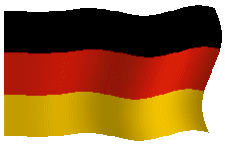
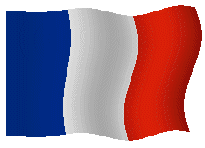
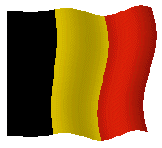
![]() IRELAND15 #3
Li�ge, Belgium to Calais
IRELAND15 #3
Li�ge, Belgium to Calais
![]()
City of Li�ge

July 16-17, 2015
Thursday, July 16, 2015
I woke up relatively early, for me, and decided to go out and re-explore this fabulous hotel. This is the room we had and you can see Marcia is up and smiley this morning. I certainly lucked out to be married to this lovely woman for 45 years and her willingness to hassle all around Europe with me all these years.
We are not in the old castle part of the hotel as we were the last time. We are in the new annex that was added. You can see that the bathroom facilities are really modern.
This is the hallway exterior of our room (below left). I would run later, so I headed to the breakfast room on the inside of the hotel and it was quite a nice layout. Too bad I don't eat breakfast. This is the room we had our coffee breaks in during our IOL Power Club Meeting here in 2011.
I then went out to the exterior veranda and the views from here are just fabulous. It reminds me of Punta Est Hotel in Italy.
Then I went exploring the exterior of the newer part of the hotel that has been designed with big events in mind.
You could sit out in this area and have breakfast and I'm sure there were more people here earlier.
Just inside those doors there is another breakfast room much more modern. Breakfast is over now.
On my way back to reception, I got a view from the front of the hotel (left) compared to that from the back.
From the reception I found my way to the nearby conference hall which is in the old part of the hotel where I knew I could get a couple of cappuccinos and relax for a while on my computer before I would go for my run.
When I was done, and couldn't put it off any longer, I said hello to the girls at reception and then headed to the front of the hotel to get the car.
The Peugeot was parked right out front. I then drove all the way down the hill and found the area in the center of town I was familiar with where it was totally FLAT to do my run.
It is literally impossible to find a place to park in this city so it took me quite some time but I finally found one. I came across the downtown Hotel am Congress Centrum (below right).
This was the Maritim Hotel (below left), where I met Wolfgang later before we took off for Li�ge. I finally got to Jul�uspromenade ...
... (above right) where the coffee shop I like is located.
It's now called the Hollywood Cafe
Bar [Juliuspromenade 18,
![]() +49-931-404-4688] (below left). They have free WiFi which in the EU is
usually called "WLAN". I did my run up and down the street and then headed
to the center where the W�rzburg Cathedral (below right) is located with all the
open markets.
+49-931-404-4688] (below left). They have free WiFi which in the EU is
usually called "WLAN". I did my run up and down the street and then headed
to the center where the W�rzburg Cathedral (below right) is located with all the
open markets.
From the map below you can see there are three areas around the Dom; the
Marienplatz above, the Unterer (lower) Markt below and left and the Oberer
(higher) Markt on the right. At 2:26 PM
I bought a bottle of cinnamon at Gewurze Wild Tea shop [Dettelbacher Gasse 1,
![]() +49-163-818-1876] for a mere �1.90.
+49-163-818-1876] for a mere �1.90.
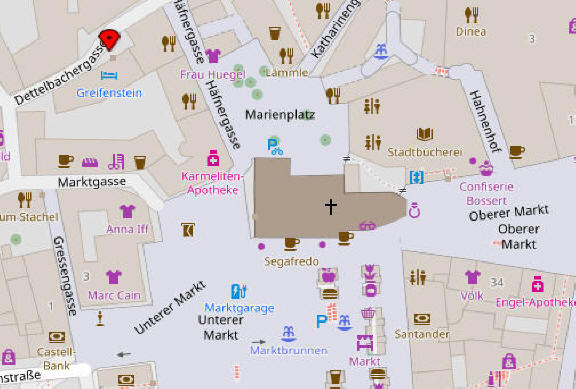
I had been looking for some kind of bag or carryall to put my running gear in so
it would be all in one place and easy to grab. I had finished running, so
at 2:36 PM, I wandered into Artisant Lederladen
[Marktgasse 9,
![]() +49-9-311-6484] (below) and he got me this red bag (right) for �80 which was
very well made. It might be a lady's bag but I didn't care; I knew it
would fit my shoes and gear in for the trip and I would give it to Marcia when
we get home.
+49-9-311-6484] (below) and he got me this red bag (right) for �80 which was
very well made. It might be a lady's bag but I didn't care; I knew it
would fit my shoes and gear in for the trip and I would give it to Marcia when
we get home.
It's a real fun marketplace with many booths set up selling just about everything ...
... including these cute little metal frogs and chickens, ...
... ducks and a variety of other weird creations.
Their trams in the downtown are really quite modern. I also got a shot of the cover of the city magazine.
I got back to the car and wound my way back up to the hotel, thanks to the GPS. We had to pack up and take off, so I checked out of the hotel and loaded the bags in the trunk. We headed back downtown to meet up with and say good-bye to Wolf and Katrine at the Maritim Hotel (below).
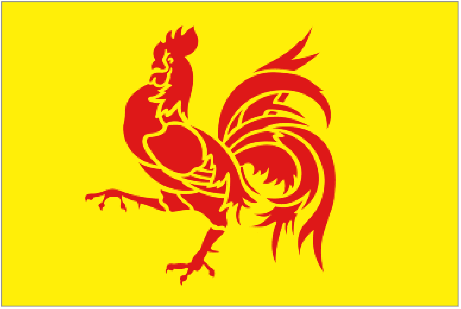
We then started our trip north then west heading into Belgium. I wanted to find a half-way point to spend the night on the way to Calais to get the ferry to the UK. I decided we should stop in a city we have never been to, Li�ge, Belgium.
Heading northwest, we passed Frankfurt, Bonn and Cologne then headed southwest
to cross the German border (map below left) and were now in
Wallonia (pink on map below
right; flag, above right), and into the
Walloon Brabant
province of Belgium. Wallonia is the bottom (southern) half of Belgium and
due to an abundance of coal was the power house for the country prior to WWII.
After the war, the northern Flemish (Dutch) region (blue, below right) became
the most prosperous and Wallonia became poorer. At 2:08 PM, we stopped for
Diesel fuel at the Shell station [721 Chaussee de Tirlemont,
![]() +33-1-021-2295] in the village of Z�trud-Lumay. It cost us �67.58.
+33-1-021-2295] in the village of Z�trud-Lumay. It cost us �67.58.
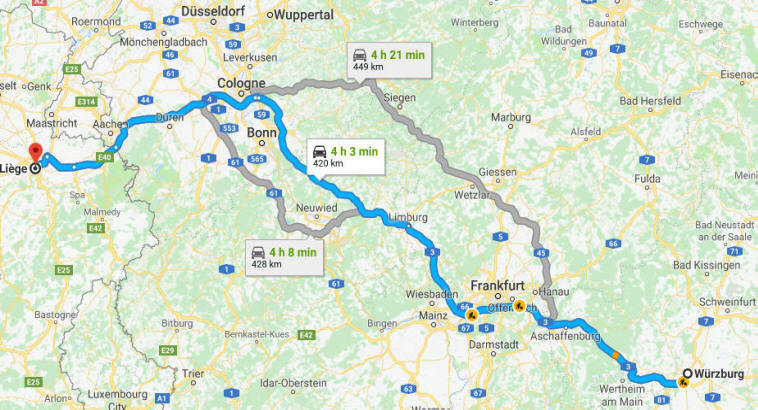
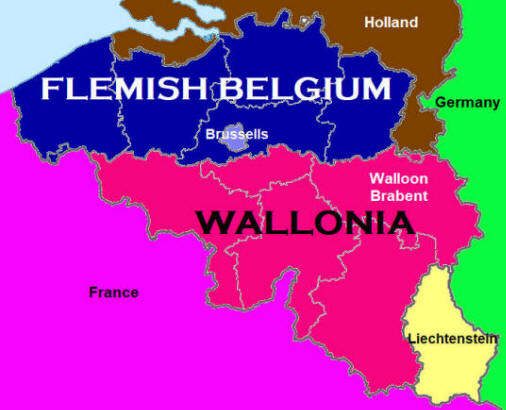
At 3:40 PM we stopped just off the highway for a break at a Lidl Store and bought a power connector and a ham and cheese sandwich which I enjoyed. I only do this on these EU drives.
Driving into Li�ge, I had to take a photo of this "dripping" church (below left) and a horribly blurry picture as we crossed the Meuse River into the center of the city. It is very hard to take a photo crossing a bridge. Try it.
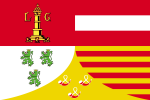

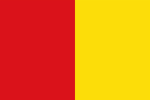
 Using the A3, this trip took us over four hours and we are finally in the
Province of Li�ge
(flag, coat of arms, left; map below left) and the
City of Li�ge (flag, coat of
arms, right; map below right) with the Meuse River cutting through it. It
is called Luik in Dutch and L�ttich in German. The city is 26.8 mi2
(69.39 Km2) in area with a population of 197,885. You can see
our hotel, Amosa, (below right) just north of the center and the Cathedral.
Using the A3, this trip took us over four hours and we are finally in the
Province of Li�ge
(flag, coat of arms, left; map below left) and the
City of Li�ge (flag, coat of
arms, right; map below right) with the Meuse River cutting through it. It
is called Luik in Dutch and L�ttich in German. The city is 26.8 mi2
(69.39 Km2) in area with a population of 197,885. You can see
our hotel, Amosa, (below right) just north of the center and the Cathedral.
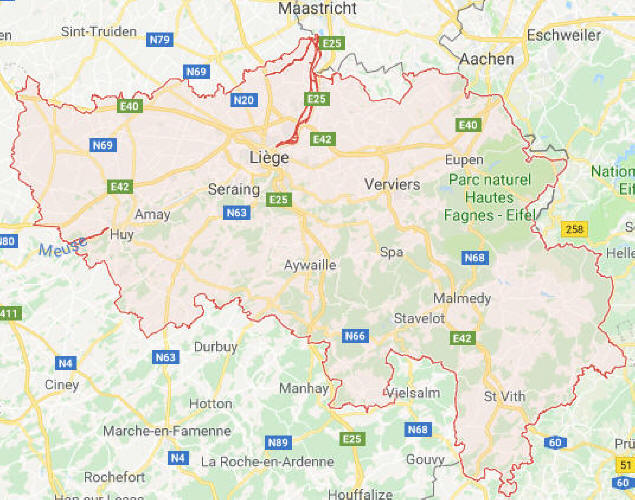
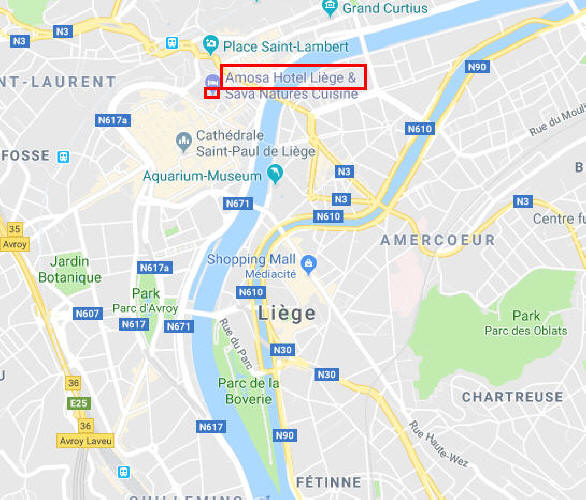
Below is a beautiful stock aerial photo of the Meuse River and the city.
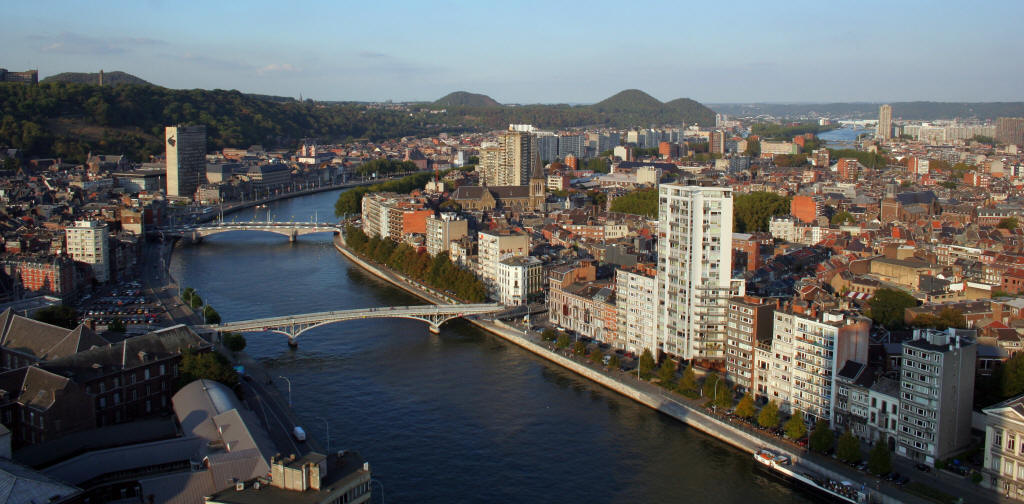
Below are drawings of the city from 1627 (below left) and 1650 (below right).
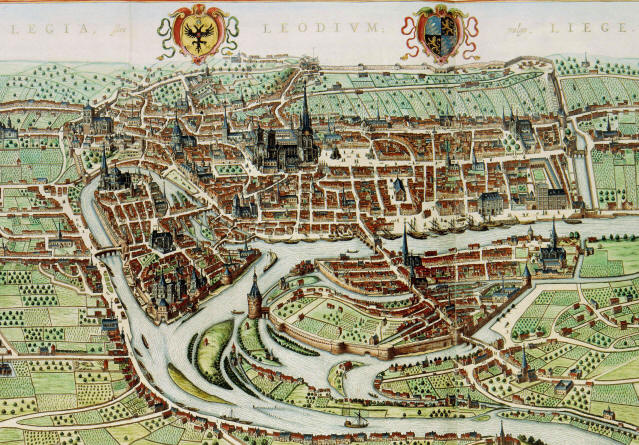
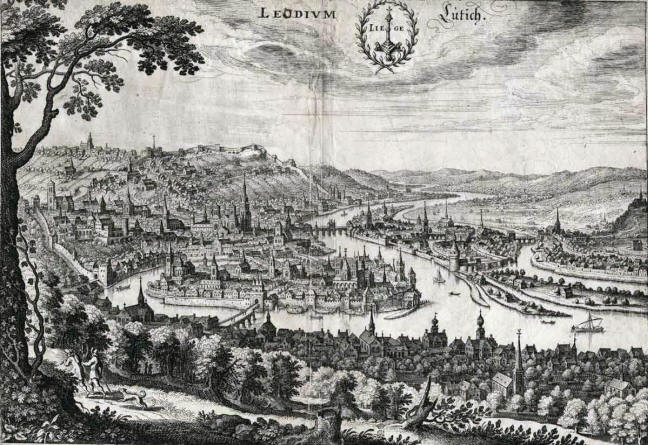
Here is a satellite shot of the city at night.
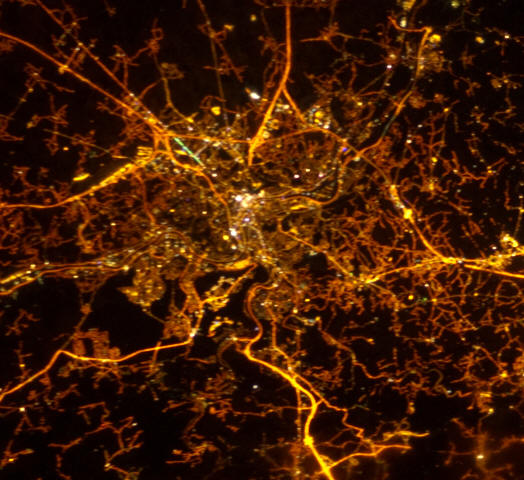
As we got closer to the hotel, we were taking a rather serpentine route to find it. The GPS found Rue St. Denis but as you can see it is blocked off to traffic (below right). I got out of the car and walked down that blocked off street and it was the white-framed building with the lights on above it, way down on the left side.
Then, there it was, right in front of me.

![]() I went inside and checked in (below left) at the
Amosa Li�ge Hotel [Rue St-Denis 4-6,
I went inside and checked in (below left) at the
Amosa Li�ge Hotel [Rue St-Denis 4-6,
![]() +32-4-331-9335] Room #101 and then asked what we should do with the car. I
walked back and told Marcia where to park it and how to get there. I
unloaded our bags and took them back and up to the room (below right).
+32-4-331-9335] Room #101 and then asked what we should do with the car. I
walked back and told Marcia where to park it and how to get there. I
unloaded our bags and took them back and up to the room (below right).
I arranged the bags in our room which was very nicely appointed (GoPro shots, below).
This is a PhotoStitch of the Canon shots.
The area near our hotel is called Place Saint-Denis but I found two different signs (below left); one using "Place" and the other using "place" - very strange.
The hotel fronts on this large open space called Place Saint-�tienne (below).
The restaurant in the hotel is called the Sava
Brasserie Resto Grill [![]() +32-4-331-9330] and claims South American flavors. After we got unpacked,
Marcia went down and staked out a table outside for a glass of wine.
+32-4-331-9330] and claims South American flavors. After we got unpacked,
Marcia went down and staked out a table outside for a glass of wine.

I decided to take a walk around the area and scout out some restaurants for dinner. I didn't really find anything so Marcia suggested we just relax and eat here. Not being a bad idea, I ordered a Hoegaarden weisse bier and joined her at the table.
That went down pretty quickly, so I ordered a local lager beer called Jupiler which was created in 1966 in the city of Jupille, thus its name. It is now owned by Anheuser-Busch (InBEV). I enjoyed it while looking over the menu.
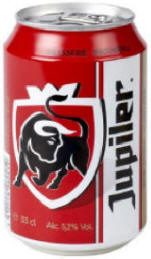

I then ordered a cup of fries. They were fabulous; could I call them Belgian Frites? Marcia had a bowl of tomato bisque.
I was really in the mood for pasta, so I had a dish of fettuccini in vodka sauce. On the left is when it arrived and on the right is after mixing it up a little. It was very good.
Marcia won the jackpot with ordering just a steak with frites. Look how perfectly they cooked it. It was better than it looked - just fantastic. I wish I had ordered it.
We enjoyed our dinners very much and highly recommend the place. We relaxed outside in the balmy evening until finally tired enough to go up to bed. Tomorrow we have to explore this city a little and then drive to Calais.
Friday, July 17, 2015
I got up early enough to make it down to the free breakfast before it closed. They have a nice place here.
These are GoPro shots of it.
These are Canon shots. You can see the red prosciutto slicer (below left) and a weighing scale on the right.
I sat down and made another ham and cheese sandwich for the trip and got a croissant to take with me while I enjoyed a Segafreda cappuccino.
It was now time for my run, so I went out into the plaza and got a shot of the hemispherical fountain outside with all the sundeck chairs around it. I started running but had no idea where I was going. Outside this plaza, the city is pretty grimy and depressing; everything is gray and dark. Had to memorize where I had come from so I wouldn't get lost. I came across this interesting building (below right) that might have been a church?
As I ran along, I came upon this once-impressive structure in much need of repair. From the flags waving out front I concluded this was the Universit� de Li�ge. It looks like it is under rehabilitation.
You can see the large statue in front of Andr� Hubert Dumont (1809-57). He was a Belgian geologist born in this city and his first work was a masterly memoir on the geology of the province of Li�ge published in 1832. A few years later he became a professor of mineralogy and geology and later the Rector of the University of Li�ge.
 Over a period of twenty years, Dumont (left) labored on a geological map of
Belgium (1849) and later expanded it to all of Europe (below). In 1840,
the Geological
Society of London awarded him the Wollaston
medal (below center), the highest award given in the field. It was to
honor
William Hyde Wollaston (1766�1828) (below left) and was originally made of
gold but, was changed to
palladium (below right) when Wollaston later discovered the metal element.
Over a period of twenty years, Dumont (left) labored on a geological map of
Belgium (1849) and later expanded it to all of Europe (below). In 1840,
the Geological
Society of London awarded him the Wollaston
medal (below center), the highest award given in the field. It was to
honor
William Hyde Wollaston (1766�1828) (below left) and was originally made of
gold but, was changed to
palladium (below right) when Wollaston later discovered the metal element.
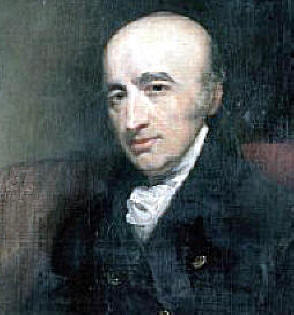
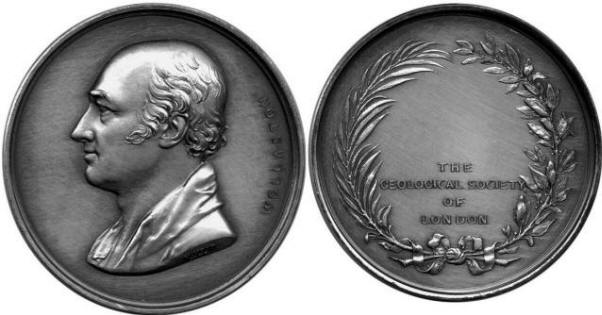
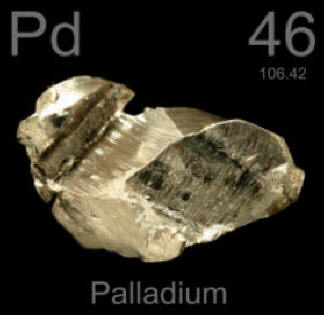
 Below is Dumont's geological map of Europe; quite an endeavor. Dumont died
at the young age of 48 in Li�ge. His son,
Andr�
(1847�1920) (right), taught at the Catholic University of Leuven and
definitively discovered mineable coal in the Campine basin
in August 1901, which lead to Belgium becoming a major coal producer and
economic powerhouse of Belgium.
Below is Dumont's geological map of Europe; quite an endeavor. Dumont died
at the young age of 48 in Li�ge. His son,
Andr�
(1847�1920) (right), taught at the Catholic University of Leuven and
definitively discovered mineable coal in the Campine basin
in August 1901, which lead to Belgium becoming a major coal producer and
economic powerhouse of Belgium.
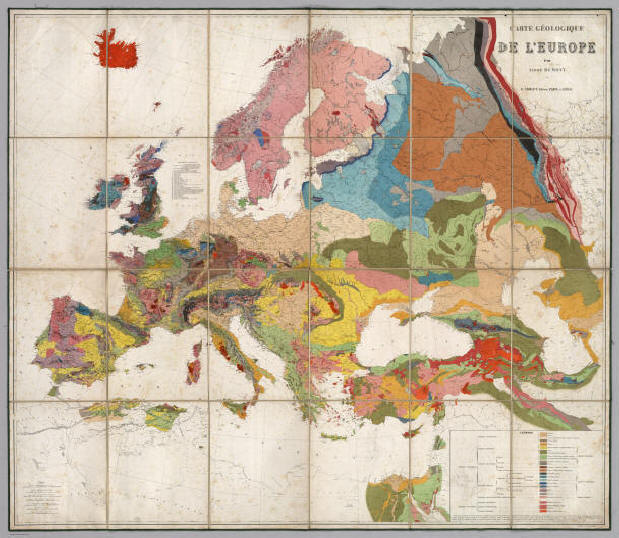
[Prior to 2009, I would try to discover who the statues and memorials were while I was there. After that, it became impossible. So, I take the photographs as I walk or run by them and research it completely months to years later when I am home and have the time. Most of them are very interesting people I had never heard of as is the case above.]
I continued running and took as many street photos as I could to demonstrate the feeling I was getting as I explored the city - I was not impressed. I had to remind myself that this city received a tremendous amount of bombing destruction in WWII due to its heavy industrialization. Its a shame.
As you can see from the street sign above, I was now on Rue de la Cath�drale. I ultimatley found the Church of St.-Denis. It and was the church I had passed early (above). The Church of St.-Denis is a former fortified collegiate church, founded by Notker, the Bishop of Li�ge in 987 and first consecrated on March 12, 990; its tower (the square at the top) was added around 1100. I was only able to identify it thanks to the stock photos (below center and right) of Jochem Bass on the internet (below) courtesy of Belgium View.
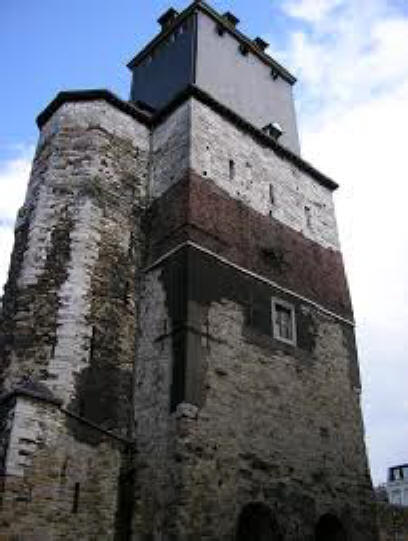
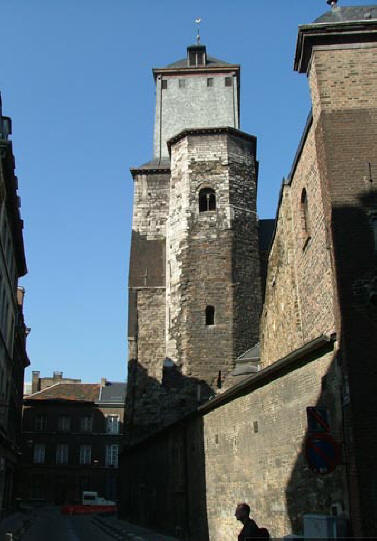
It is amazing how similar my photo (above left) is to his photo (above center). When I first took the shot, I though it was an abandoned structure. I really didn't get many photos of the church's exterior so here are more of Jochem's excellent shots. Now it looks like a church instead of a fortress.
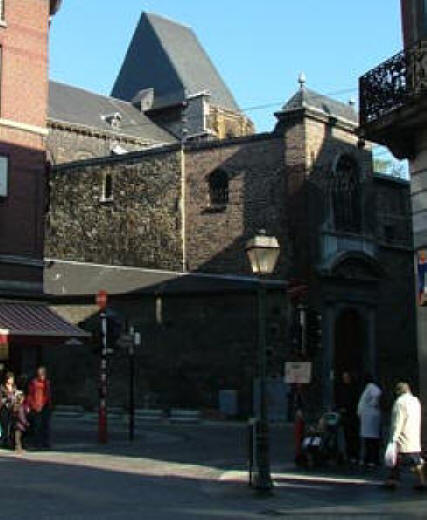
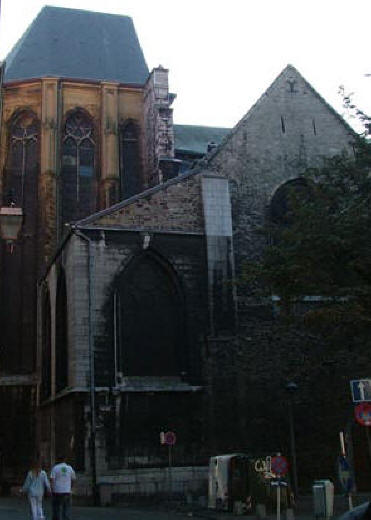
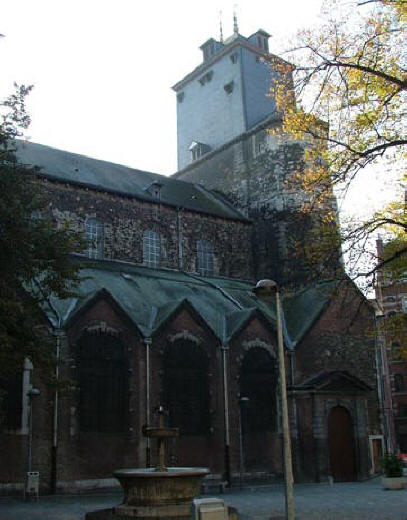
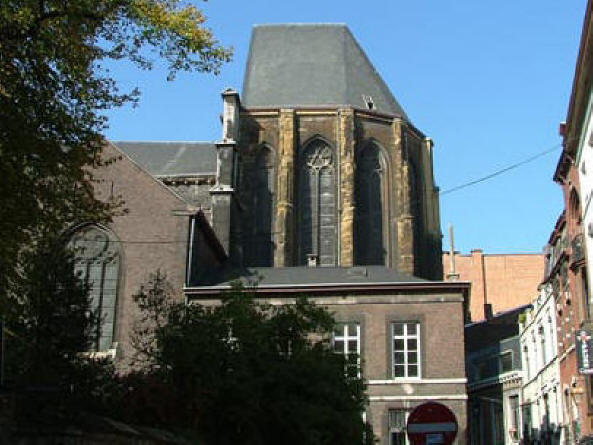
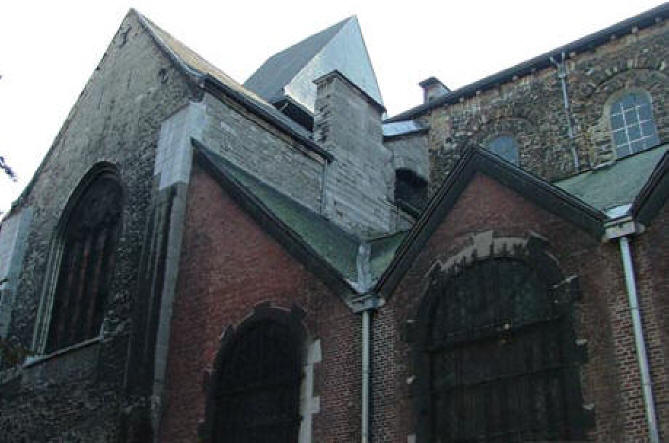
I went inside and just at the entrance they had this white model of the church encased in plastic.
I got this shot of the main altar (below left). Jochem's shot (below right) is a little darker.
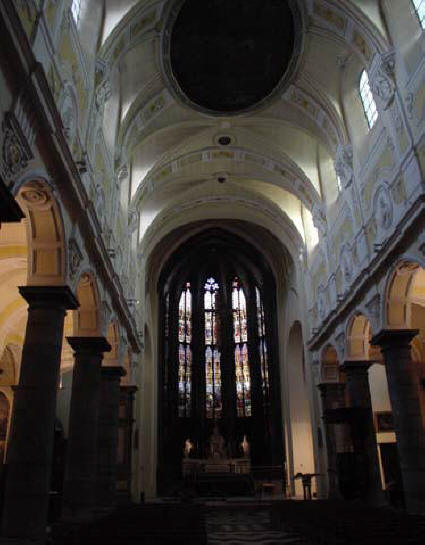
I was probably luckier with a sunnier day. Again, my shot (below left) is brighter but his (below center) is able to show more detail in the stained glass since its darker inside. His shot (below right) of the main altar with a tomb.
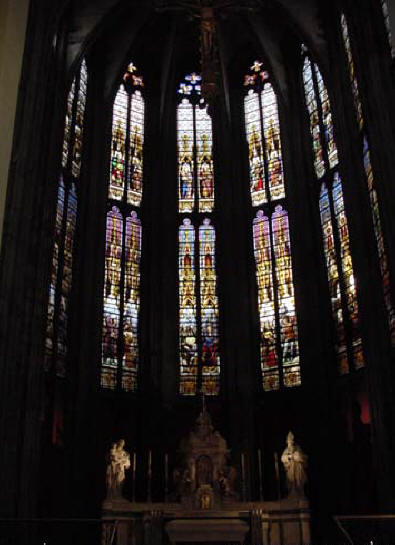
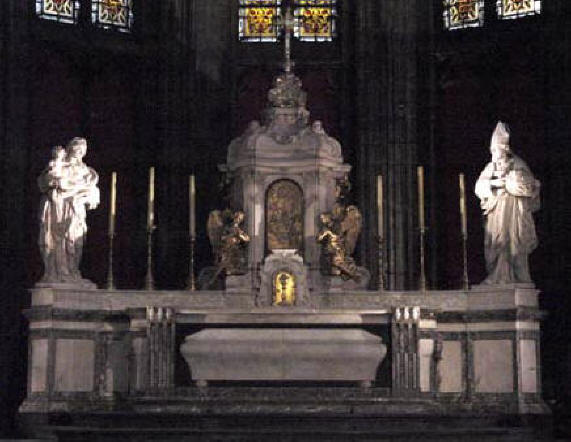
But here is an even nicer stock photo I found of the altar (below left). Below right is a painting of St.-Denis from 1850. Download it, blow it up and look at the scene of the people outside.
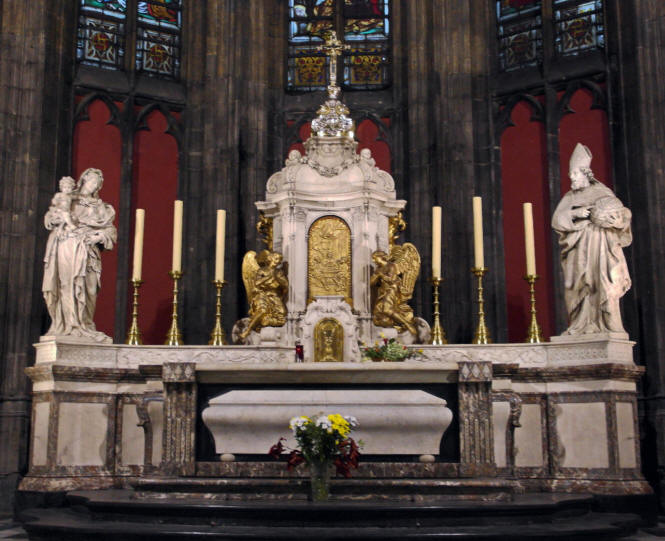
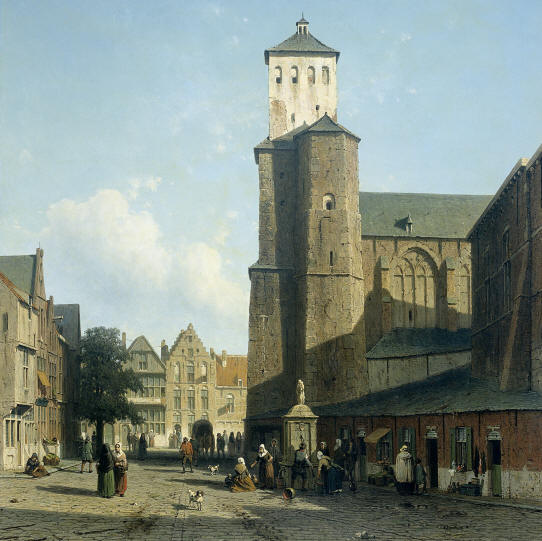
Looking back at the entry door, my shot of the interesting organ is brighter than his (below right).
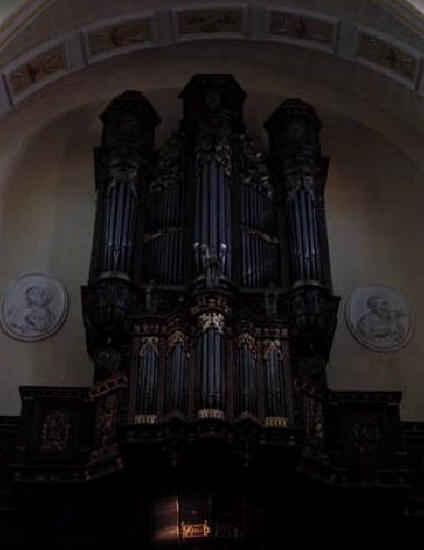
My shot (below left) of the cieling is similar to his, but his is a more close up of the central art.
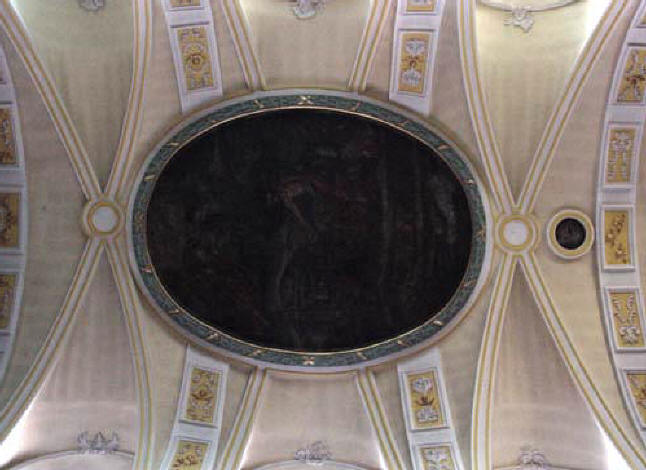
Here are four of Jochem Baas's photos (L-R) of: a column, side cieling, wood carving and base of pillar showing the levels of the flooding that occurred in 1926, the year of the big flood in Li�ge. I missed all those. Thanks Jochem.
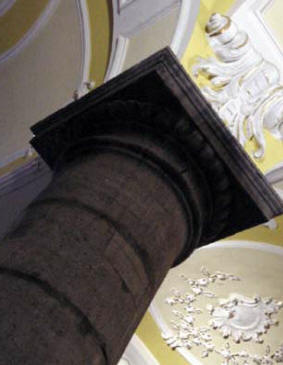
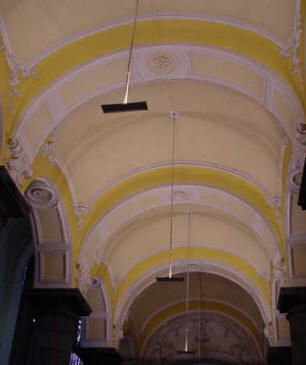
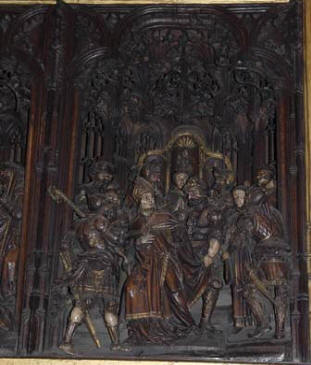
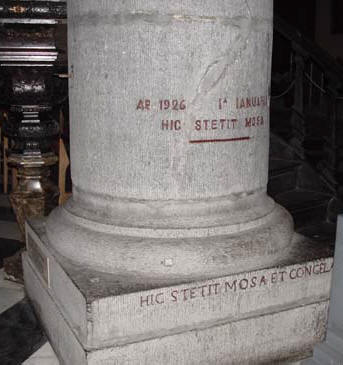
As I leave the church, it is important to point out that I can't visit the most important historic church of this city, Saint Lambert's Cathedral. It was dedicated to St. Lambert (636-705), bishop of Maastricht, who was assassinated (below left) in Li�ge in 705 and buried in Maastricht. Soon afterward, St. Hubert brought his remains back to Li�ge and built a memorial to him and later built a basilica near Lambert's old residence. Below right is a drawing of what a huge complex it became by 1770.
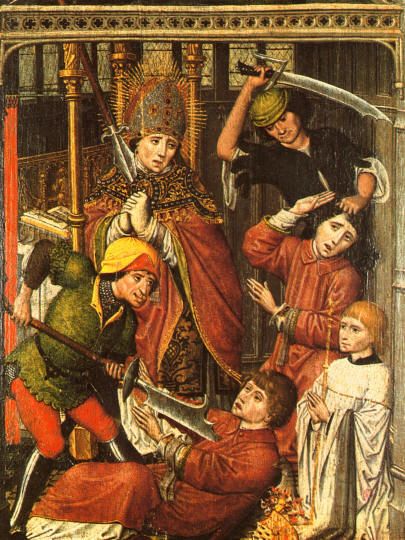
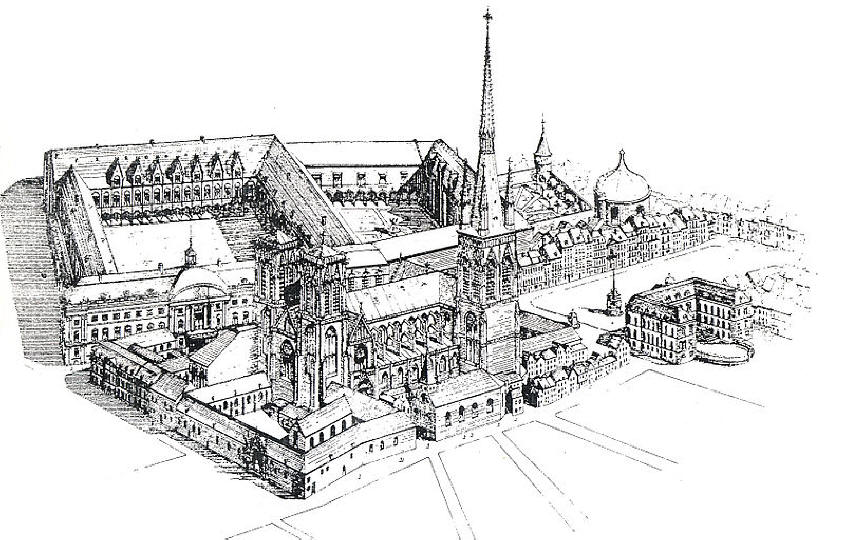
In 978, Bishop Notger installed a chapter of sixty canons and later built a new church in Ottonian style starting around the year 1000. In April 1185, a violent fire broke out and the cathedral was totally destroyed.
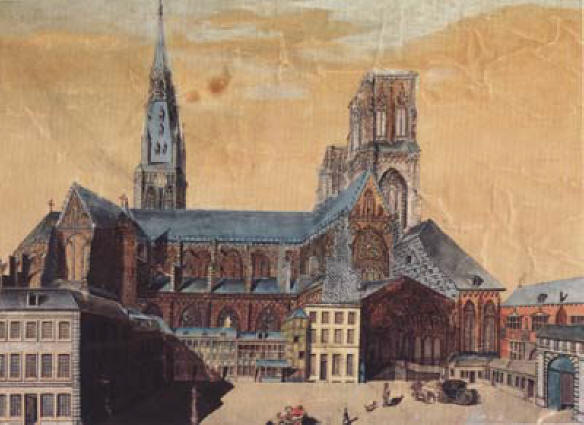
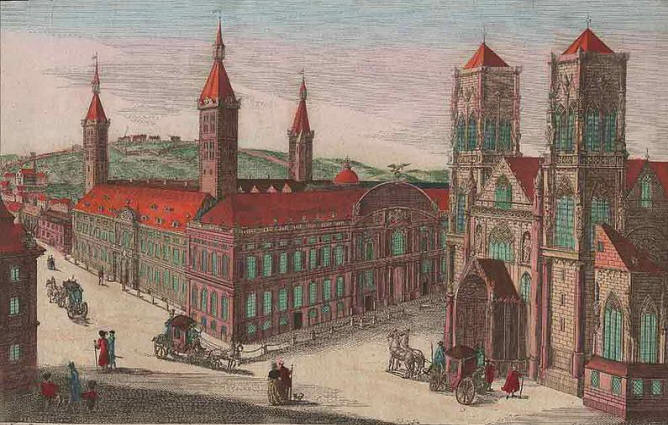
Reconstruction began the next day, in the Gothic style (above), extensively using the previous foundations. Most of it had been restored by 1189, when the Archbishop of Cologne came to reconsecrate the church. In 1197, the relics of St. Lambert, safely stored since the fire, were reinstalled in the new building. Above are depictions I found of what it looked like in 1780 (above left) an in 1790 (above right). As a result of the French Revolution, in 1794, the revolutionaries (r�volution li�geoise) took over Li�ge an began destroying it and the site was entirely leveled in 1827. Thus the city's central, most important Cathedral no longer exists. Here are depictions of its ruins.
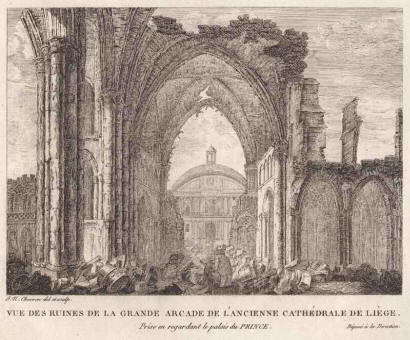
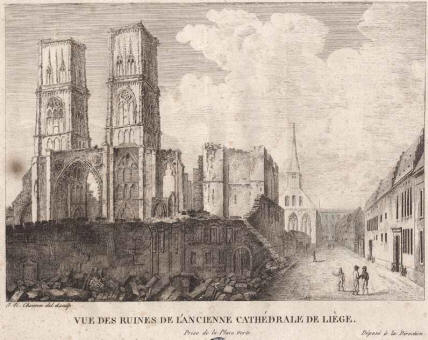
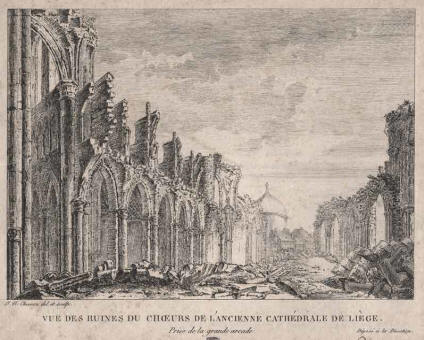
Today, Li�ge's cathedral is called
St. Paul's Cathedral
[Place de la Cath�drale 6,
![]() +33-32-4-232-6131] (below) and was founded in the 10th Century. It was
rebuilt from the 13th-15th centuries and restored in the mid-19th Century.
It became a cathedral in the 19th Century due to the destruction of Saint
Lambert Cathedral in 1795 and is the seat of the Diocese of Li�ge.
+33-32-4-232-6131] (below) and was founded in the 10th Century. It was
rebuilt from the 13th-15th centuries and restored in the mid-19th Century.
It became a cathedral in the 19th Century due to the destruction of Saint
Lambert Cathedral in 1795 and is the seat of the Diocese of Li�ge.
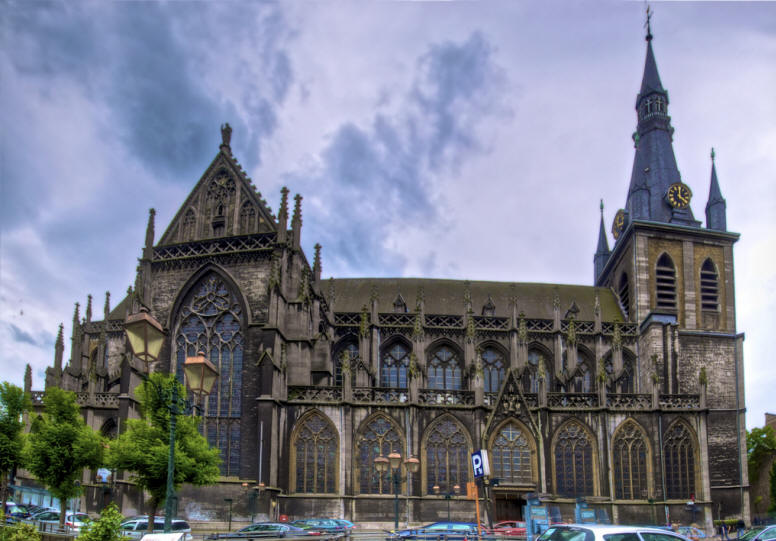
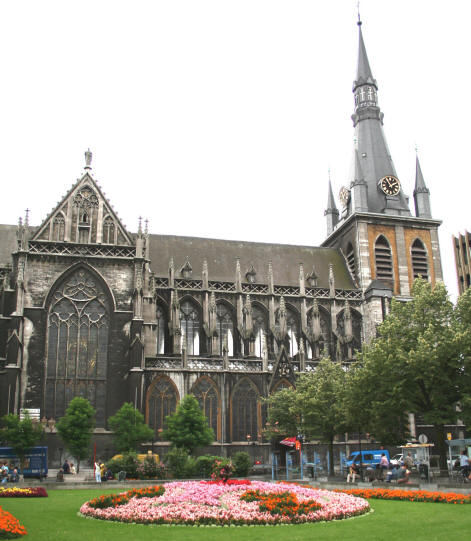
Here is a stock photo panoramic view of the interior.

Below are stock photos of the interior; the left shows the altar and the pulpit on the right side. In the center is face on shot of the statues in front of the pulpit and on the right is the statue on the other side of the pulpit which is from 1848 and is known as "Genius of Evil" or "Lucifer". I have no idea why.
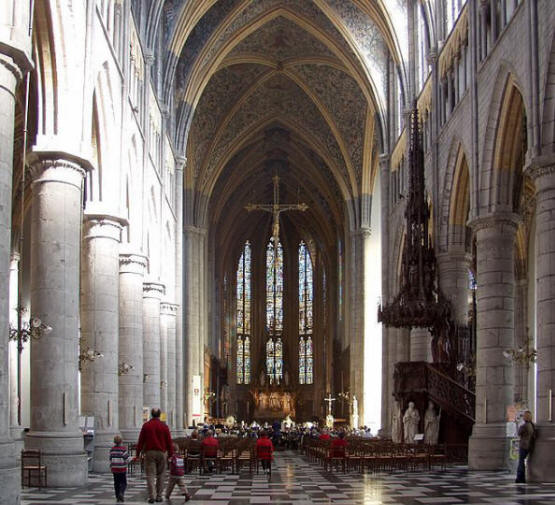
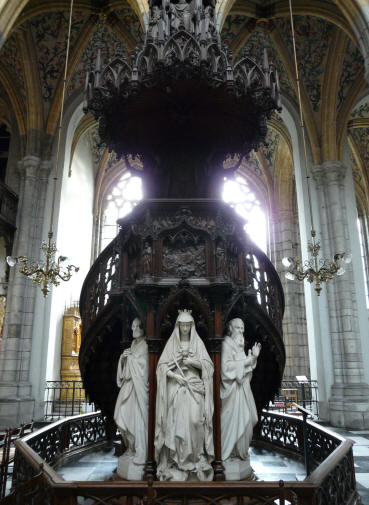
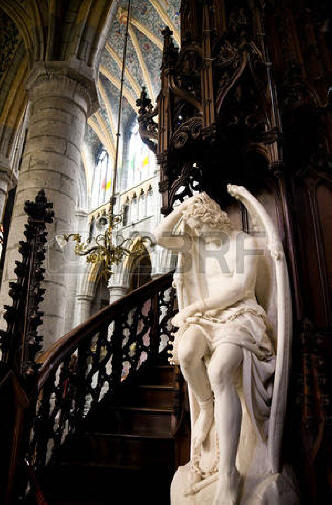
Below left is the side aisle showing the lightness caused by the Meuse River bluestone which is enhanced by the yellow tuffeau of Maastricht and the yellow limestone of Lorraine. Below right is the beautiful ceiling (stock).
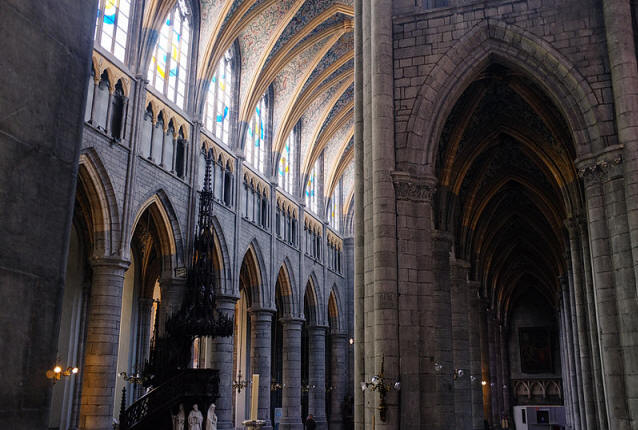
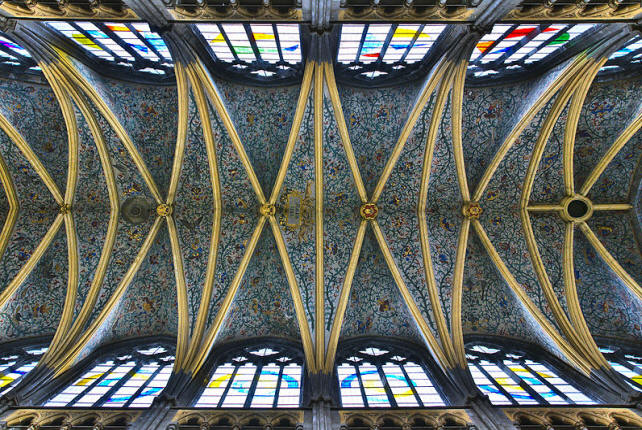
Below left is the abbey chapel altar and on the right are ones of the St. Lambert reliquary in the Treasury.
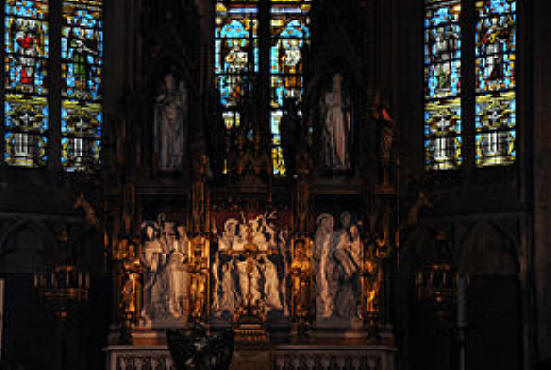
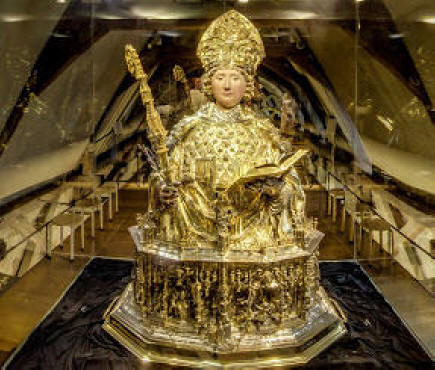
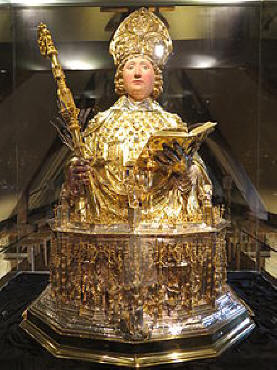
Below left is a list of the main Catholic churches in the city along with an old drawing map of them from the 1600s showing the large St. Lambert's in the center and the other six collegiate churches.
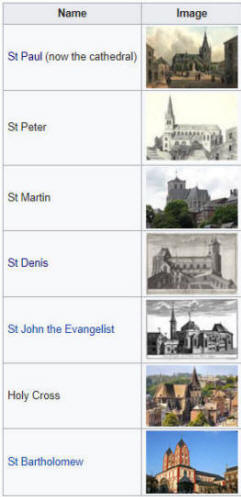
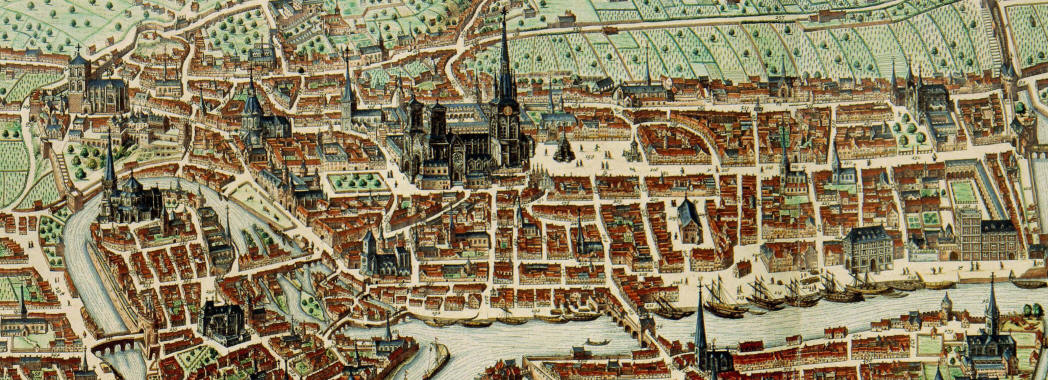
An important Catholic historical legacy of this city is that St. Juliana of Li�ge (1193-1258) (below left) pushed incessantly for the institution of the feast of Corpus Christi starting in 1230. [Luttich is Li�ge in German.]
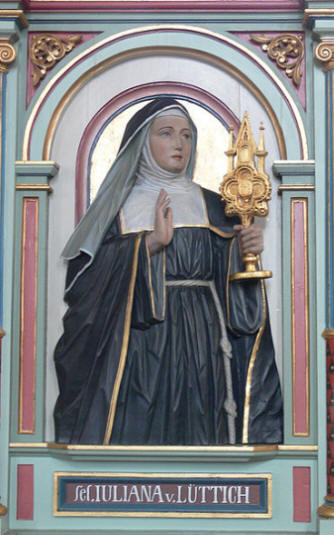
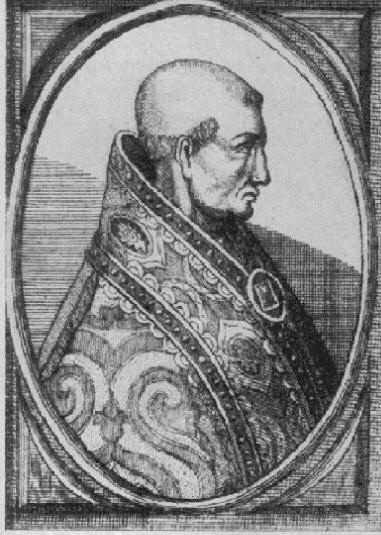
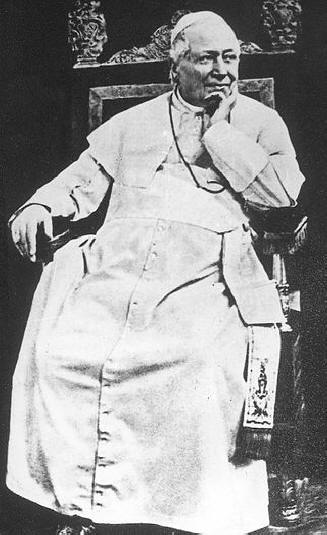
The feast of Corpus Christi was first celebrated in Li�ge in 1246, and then, in 1264, it was adopted for the universal church by Pope Urban IV (1195-1264) (above center). She was declared a saint in 1869 by Pope Pius IX (1792-1878) (above right), the second longest reigning Pontiff (31 years) after St. John Paul II.
As I continued my run through the center of the city, I kept getting the impression of how dark and lifeless it seemed to me; the people didn't look happy either. I almost felt uncomfortable and wary of where I was going yet I wanted to explore it. I took many shots as I ran around (below).
You can see (below left) on the right-hand sidewalk how the metal pylons keep cars from parking on sidewalk.
I was now in "The Square" since the pavement is labeled: in German "Das Quadrat" (left), in French "Le Carr�" (top), in Dutch "Het Vierkant" (bottom) and Li Cw�re (right) in Catalan Spanish.
A little PhotoShop distortion gives a view from overhead.
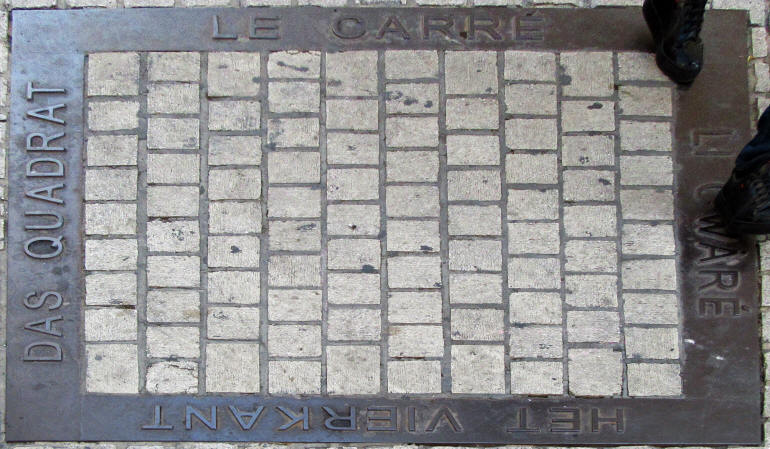
I discovered this a great place for bars and restaurants where the students hang out for fun (stock below left). There is also the Tres Font near here but I never saw it (below right).
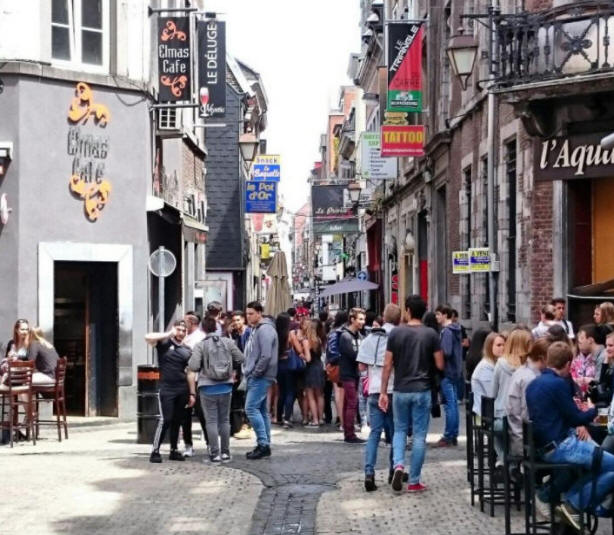
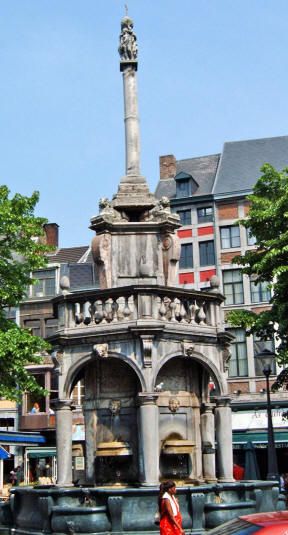
Here I was on Rue Saint-Jean-en-Isle looking down a side street.
Believe it or not but this street is called Rue Tete-de-Boeuf (Head of Beef) and is quite skinny (center). I blew it up (right) to show all the shops and signs but few people.
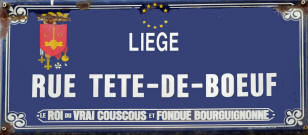
I came across a lot of little streets that I ran by or down.
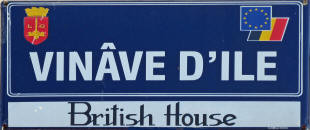
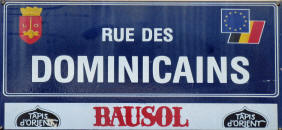
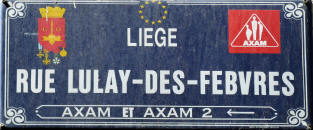
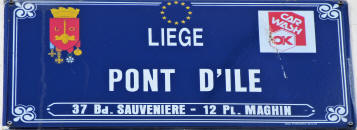
I ran up and down this little street below. Here is looking at it heading one way (left) and heading the other (right). I took the shot because I wanted to get a photo of the little old man shopkeeper (below right) standing outside his men's store. He had gotten extremely mad at me and abusive when I went in and asked him something about some clothes I was looking at.
He literally yelled at me because I didn't understand French and kicked me out of his store. It took me several passes to finally get a shot of this poor miserable old soul (below left). He did everything to prevent me from photographing him, but I finally got it. I'll never forget the incident or him. After completing my run and exploring, I finally got back to the square in front of my hotel (below right).

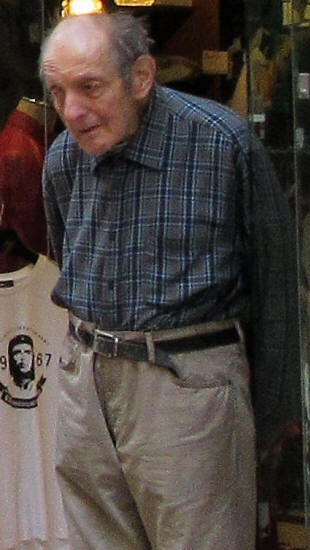
In the square is the Galeries St-Lambert shopping center. I decided to go in and take a look.
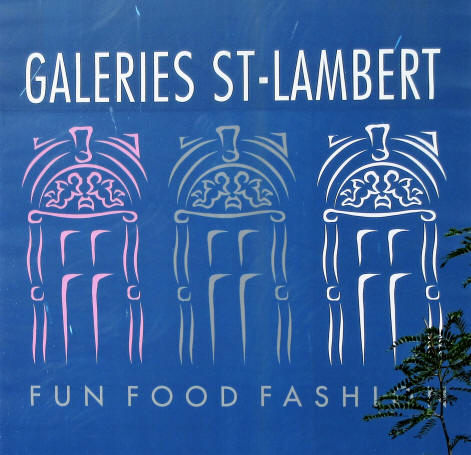
 It was a real modern shopping center as you would see anywhere in Europe or the
U.S. There were even the ubiquitous preteens "hanging out at the mall".
At 12:11 PM, I went into the Hema Store [Place St-Lambert 21,
It was a real modern shopping center as you would see anywhere in Europe or the
U.S. There were even the ubiquitous preteens "hanging out at the mall".
At 12:11 PM, I went into the Hema Store [Place St-Lambert 21,
![]() +32-4-220-7010] and bought something for �6.
+32-4-220-7010] and bought something for �6.
I got back to the hotel, changed, packed and did my checking out. The ladies here (below) were great to us and we would recommend this hotel to anyone coming to Li�ge.
We went to the parking garage (below left) across the plaza to get our car and I loaded it up. I got this shot of the plaza (above right) in front of our hotel (on far left); you can see the blue Galerie sign far right. We took off heading out of the city to Calais. These are some of the shots I got from the car as we were leaving the city. Below right is St-Lambert Square with its bus station and the Palace of the Prince-Bishops.
Here are more stock photos I found of the Palace.
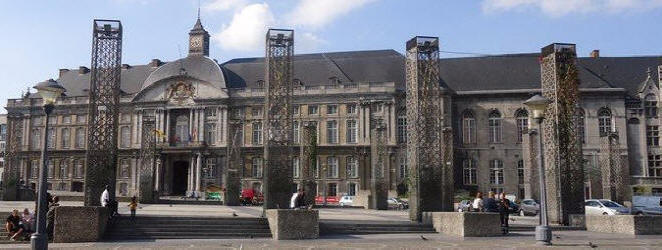
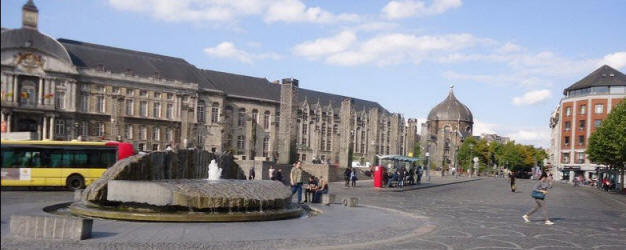


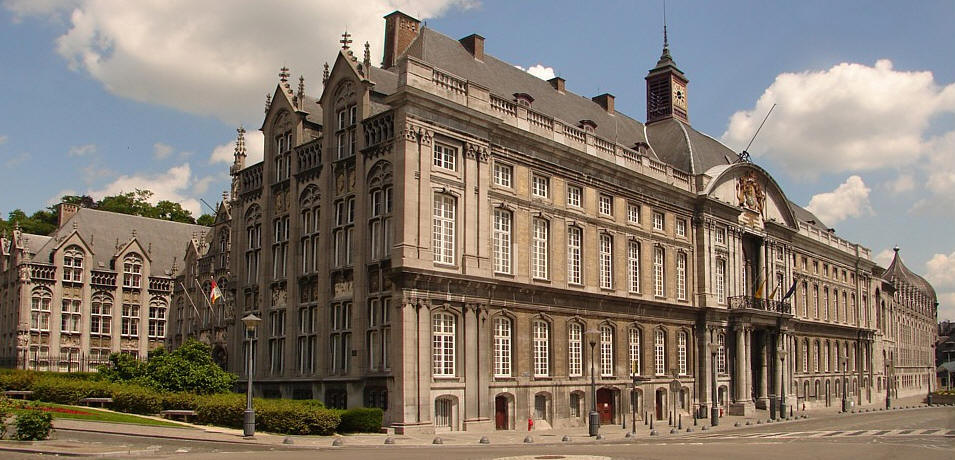
Of course I never found time to go inside, so here are some stock photos of the exterior passageways (below right) of ...
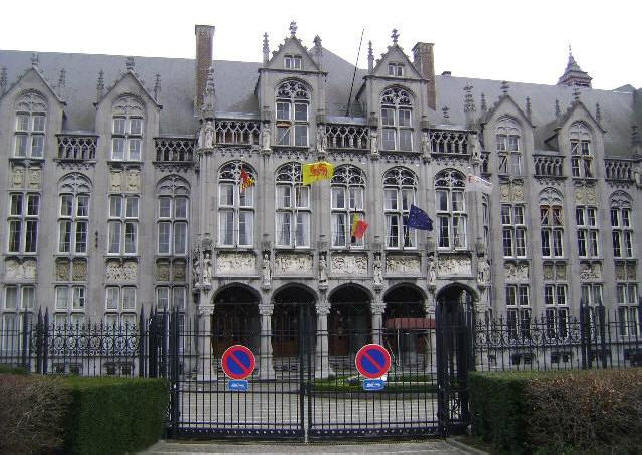
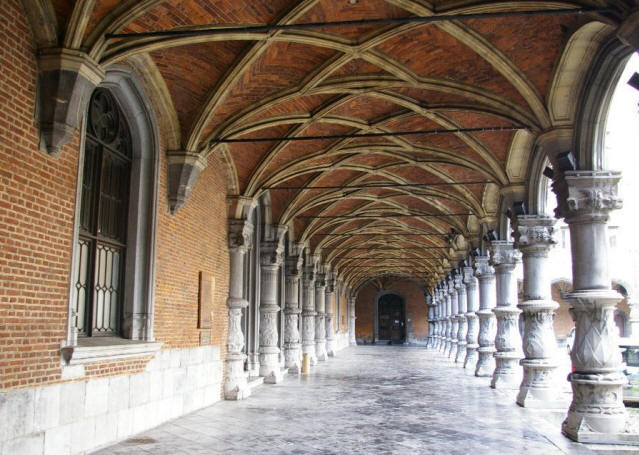
... the interior courtyard (below).
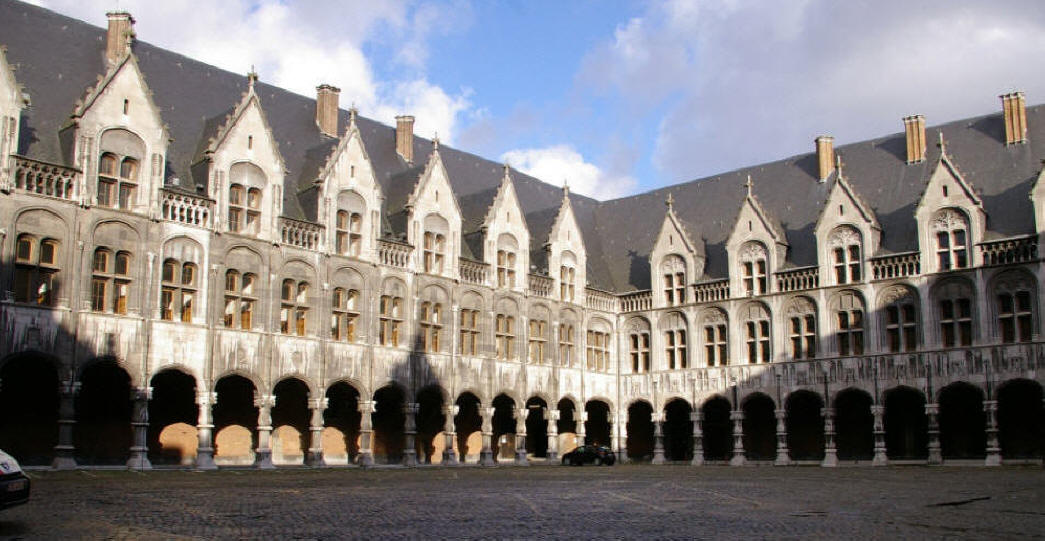
I took some shots of buildings I thought were interesting as we headed toward the highway.
I must admit that I may have not been fair to the city of Li�ge in my short 24 hours here. There are many places I did not have time to see. It would not be fair to not show these important structures. Here are some examples (all stock photos). First is their beautiful modern train station called Gare des Guillemins.
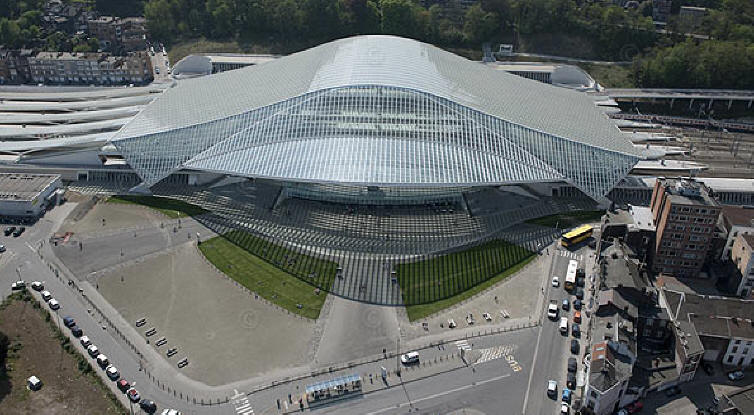
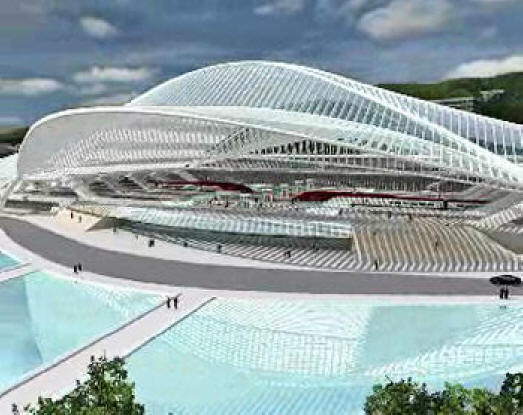
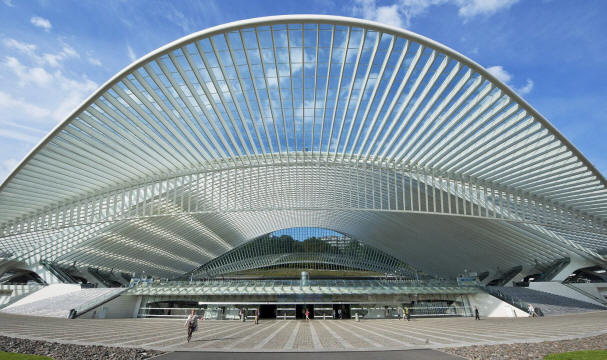
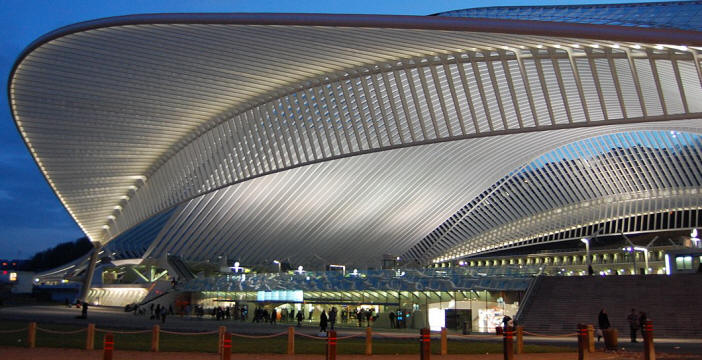
The station was designed by architect Santiago Calatrava and officially opened on September 18, 2009. It cost �312 million ($434 million) to build.
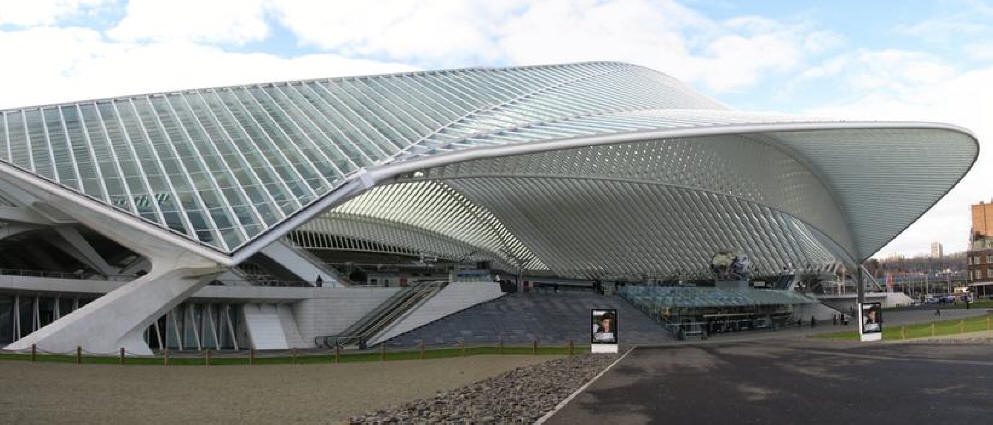
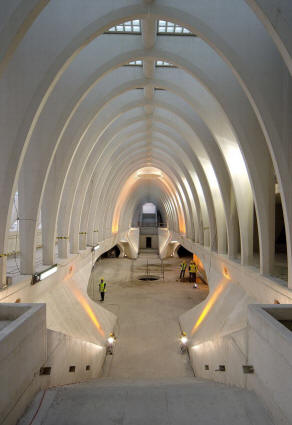
The interior is also quite dramatic (above right and below). It is made of steel, glass and white concrete and includes a monumental arch 525 ft (160 m) long and 105 ft (32 m) high.
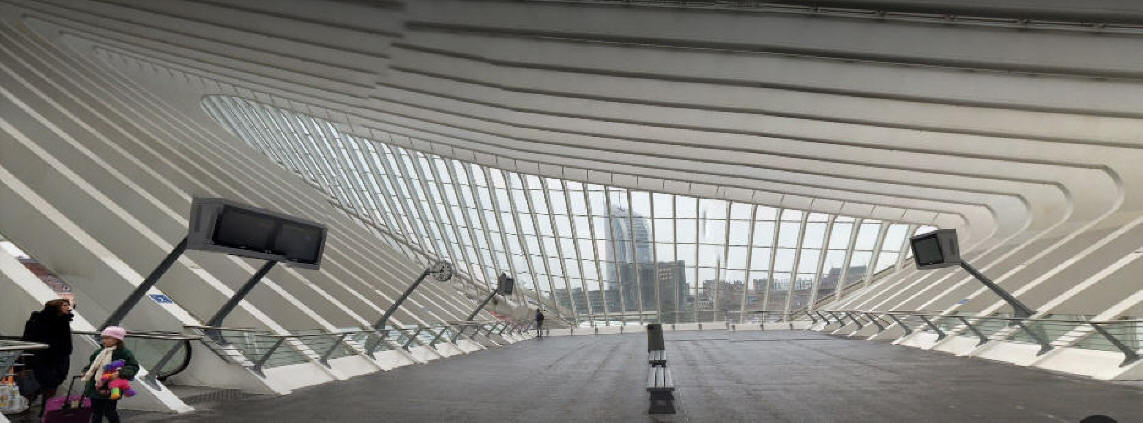
It has nine tracks and five platforms and all the tracks were modernized for high speed arrival and departure (high speed ICE train below).
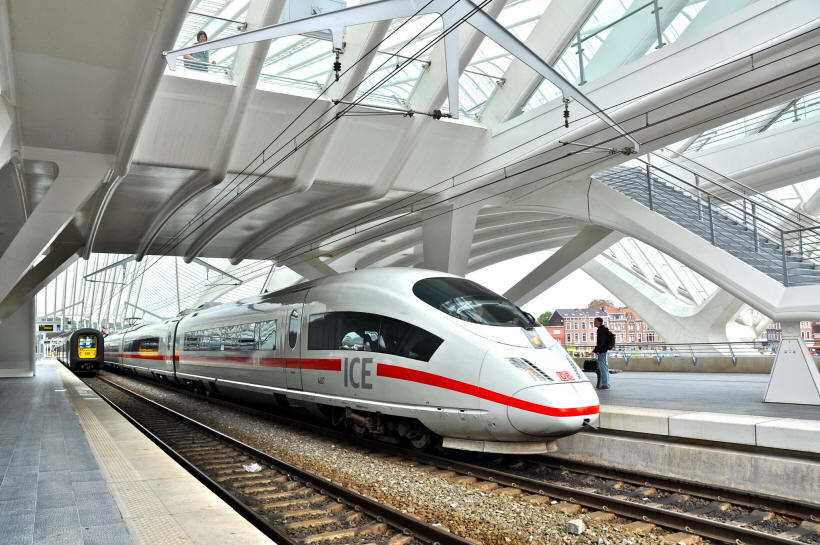
They also have a very nice opera house. It is called Opera Royal De Wallonie.
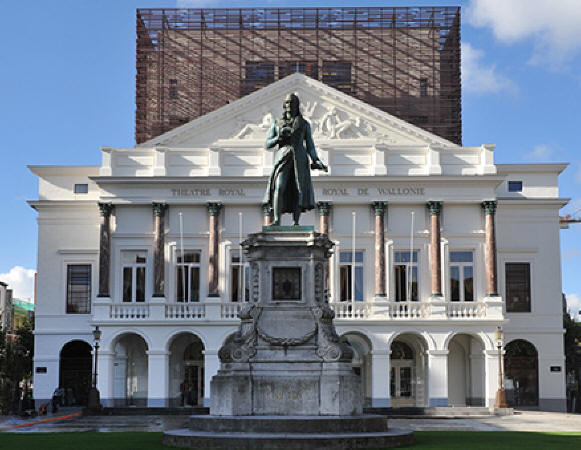
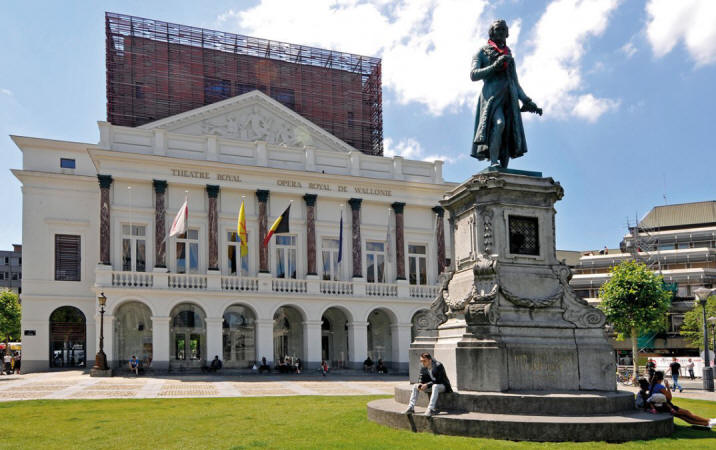
The bronze statue in front is of Li�ge composer Andr� Ernest Modeste Gr�try (1741-1813) (below) most famous for his op�ras comiques (comic operas). Here is the opera house at night (below center).

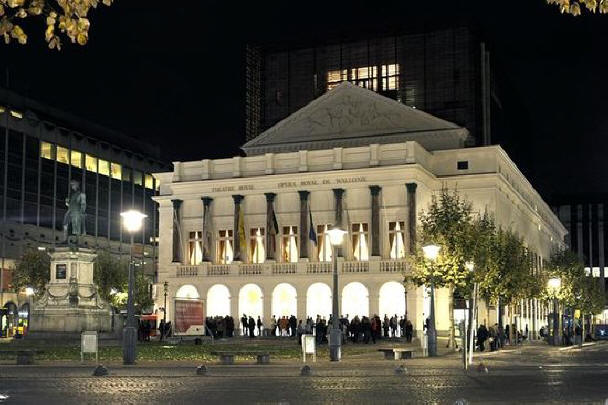
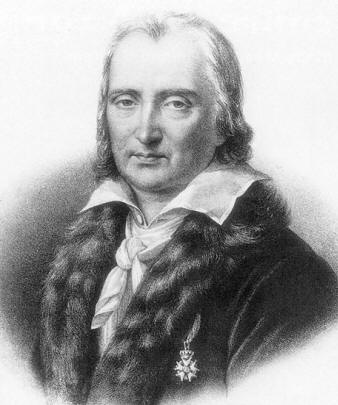
Here is the magnificent interior of the opera house with a close up of the stage.
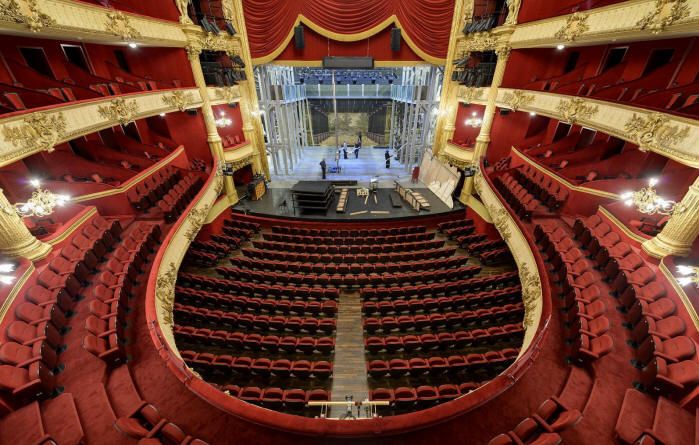
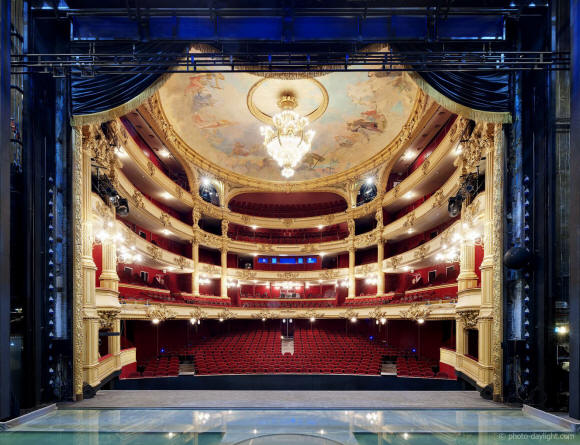
They also have a regional theater.
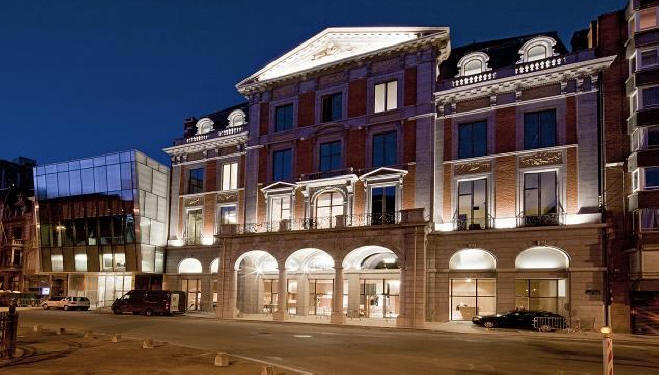
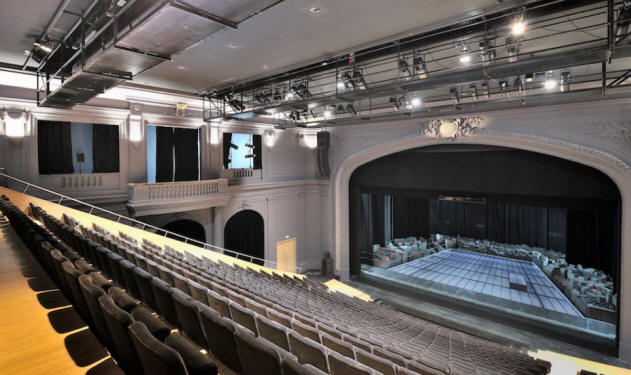
There is also their City Hall and this famous old castle outside the city.
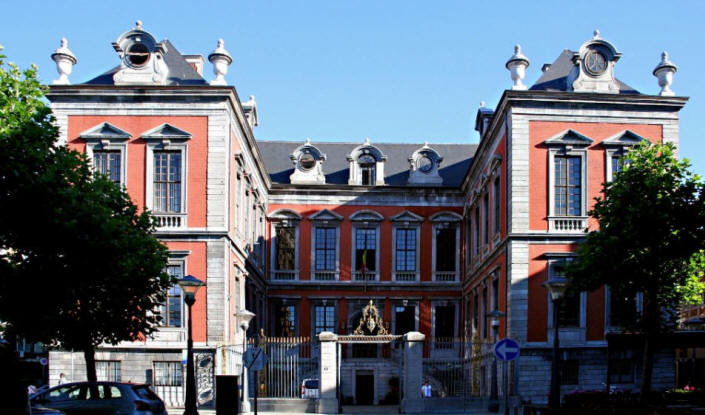
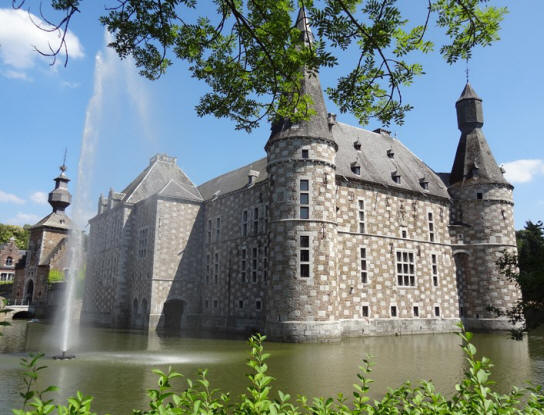
As we are driving out, I love to see the sign "Toutes Directions" (All Directions) sign. What does that tell you?
We are heading west on the E40 towards Bruxelles, the capital.


We stopped to change drivers and get some gas. We filled up at a Shell station with over 55 liters of diesel for �67.58.

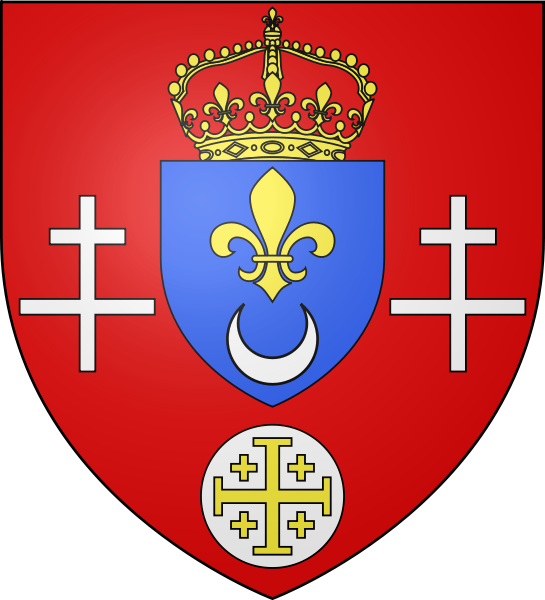
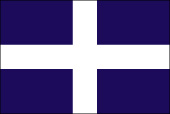 It was a three hour drive to
Calais (City flag left, coat of arms right) bypassing the capital Bruxelles
and the cities of Ghent, Bruges, Ostend and Dunkirk. You can see the
English port of Dover on the upper left where we will ferry to tomorrow.
The link above has more information than I could find in any of my thick tour
books of France.
It was a three hour drive to
Calais (City flag left, coat of arms right) bypassing the capital Bruxelles
and the cities of Ghent, Bruges, Ostend and Dunkirk. You can see the
English port of Dover on the upper left where we will ferry to tomorrow.
The link above has more information than I could find in any of my thick tour
books of France.
The city's history is one of back and forth; it was always French (Gallic) until 1347 when it was annexed by England's King Edward III and grew into a thriving center for wool production. The population of the metropolitan area in 2010 was 126,395. Today over 10 million people visit this port annually.
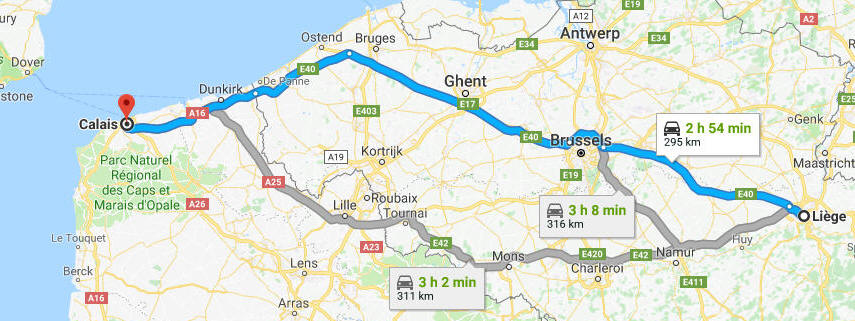
The maps below show the center of the city and the port terminal complex in the top portion. That is where we have to go tomorrow. My opinion of Calais was not that high based on our last time here in 1999 when we crossed the Channel for are UK trip. It seemed just a dirty port city to me. The GPS took us right to our hotel.
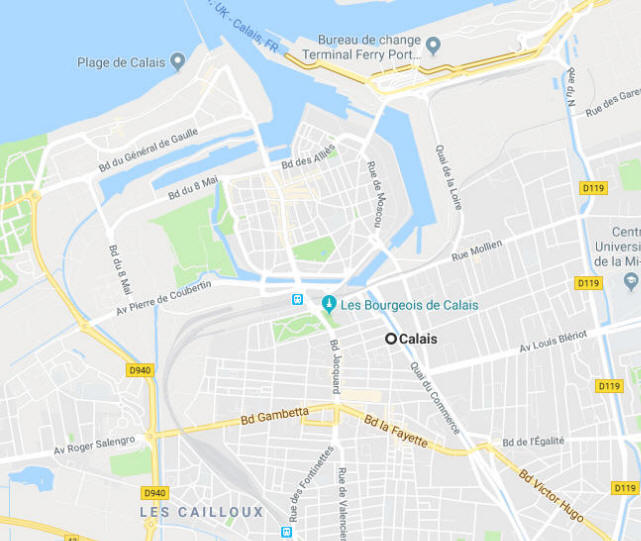
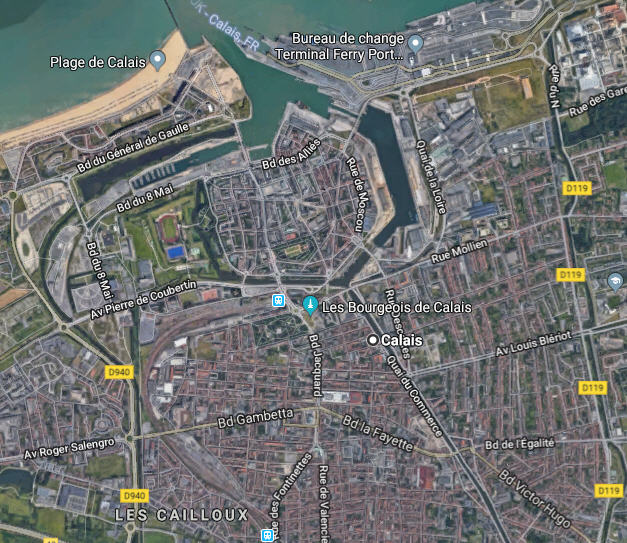
 We arrived at the Hotel Meurice [5
Rue Edmond Roche,
We arrived at the Hotel Meurice [5
Rue Edmond Roche,
![]() +33-32-134-5703] which I had
+33-32-134-5703] which I had
![]() booked
with Booking.com for �115.70. We are in that little "island" in the upper
center. The hotel is directly across the street from the Mus�e des
Beaux-Arts de Calais (map, below right).
booked
with Booking.com for �115.70. We are in that little "island" in the upper
center. The hotel is directly across the street from the Mus�e des
Beaux-Arts de Calais (map, below right).
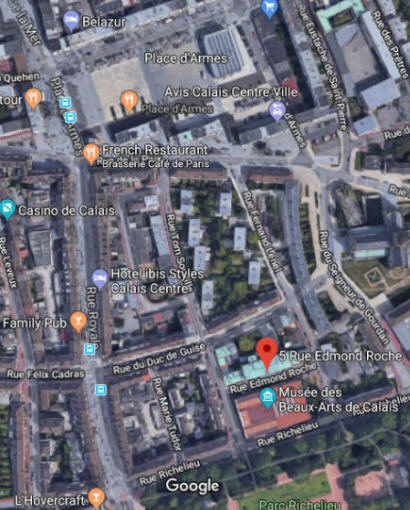
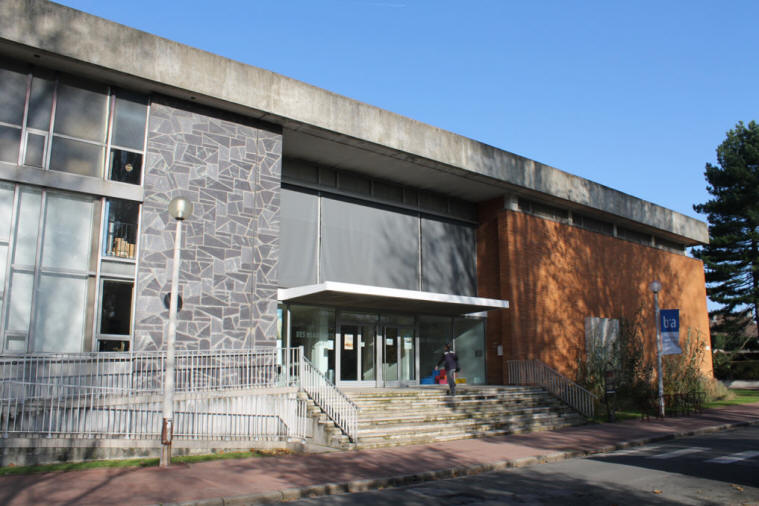
I later learned that this hotel has quite a history. It was founded here in 1771 by Charles Augustin Meurice (1738-1820), who became a postmaster on the Calais-Paris route. Before the French Revolution, many British upper class traveled to Paris and when they landed here after crossing the Channel, had to find a place to stay before starting their 36 hour trip to Paris. Meurice decided he could make some money out of them by putting them up in his local coaching inn and escorting them to Paris with his coach service. In 1817, Meurice built a second coaching inn in Paris to welcome the weary travelers called the "Le Meurice" (stock photos below). He made sure all the personnel spoke English.
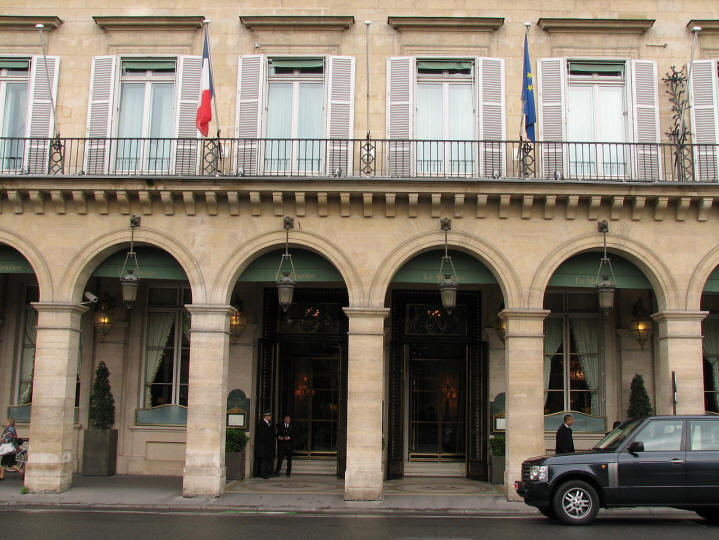
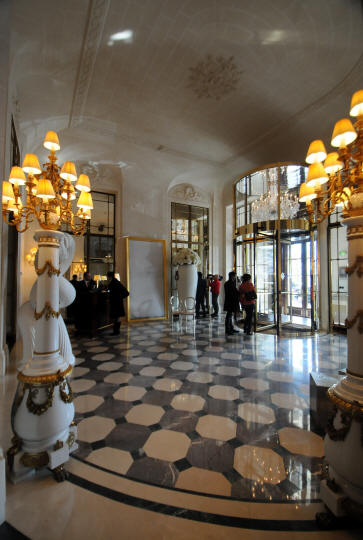
In 1835, 15 years after his death, his Paris hotel moved to its present site,
overlooking the Tuileries. In 1855, Queen Victoria stayed at Le Meurice
while in Paris, cementing the reputation of the hotel forever, making it the
playground of the elite aristocracy. In 1898, a limited liability company
named H�tel
 Meurice
was formed to own and operate the hotel. In 1905, they undertook a major 8
million franc renovation of the hotel, which gave
Meurice
was formed to own and operate the hotel. In 1905, they undertook a major 8
million franc renovation of the hotel, which gave
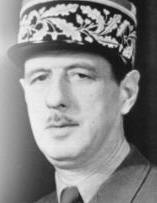 it
individual private baths. In 1907 King Alfonso XIII was one of the first
guests to stay at the newly renovated Meurice. Between 1914-18, during
WWI, the hotel closed for several months, and it served for a time as a hospital
for wounded soldiers. In 1918, Picasso and his bride Olga Koklova selected
Le Meurice to host their wedding dinner there. It was destroyed
it
individual private baths. In 1907 King Alfonso XIII was one of the first
guests to stay at the newly renovated Meurice. Between 1914-18, during
WWI, the hotel closed for several months, and it served for a time as a hospital
for wounded soldiers. In 1918, Picasso and his bride Olga Koklova selected
Le Meurice to host their wedding dinner there. It was destroyed
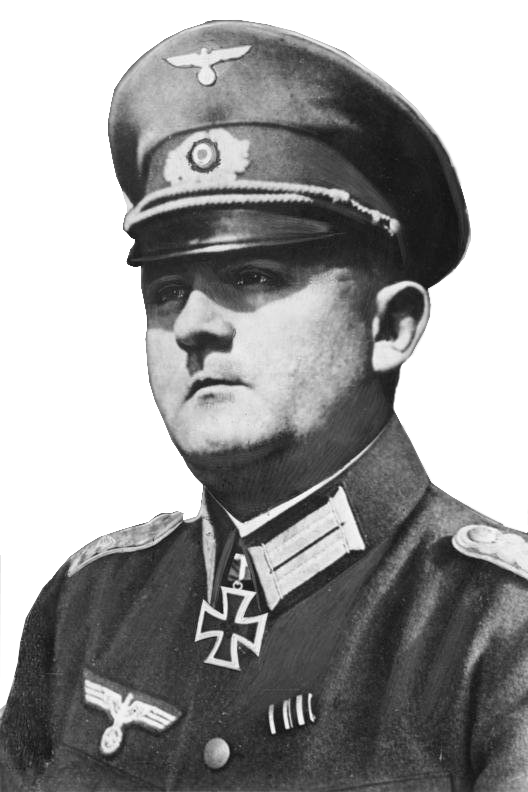 during
WWII and rebuilt in 1953. Salvador Dali spent much time at the Le Meurice.
Charles De Gaulle (left) stayed here in 1959 and in the 1960s Salvador Dali
(above right) spent long periods of time at the hotel.
during
WWII and rebuilt in 1953. Salvador Dali spent much time at the Le Meurice.
Charles De Gaulle (left) stayed here in 1959 and in the 1960s Salvador Dali
(above right) spent long periods of time at the hotel.
But, most famously, in August 1944, it became the residence and military headquarters of the last German Nazi governor of Paris, General Dietrich von Choltitz (1894-1966) (right) who famously ignored Adolf Hitler's direct orders to destroy and flatten Paris on his departure. He felt the war would be lost and that Hitler was now insane. Who could imagine a Nazi would become a hero of France?
Our hotels are always a surprise, but this one didn't look too bad. Of course it was fun rolling all the bags up those stairs without a ramp.
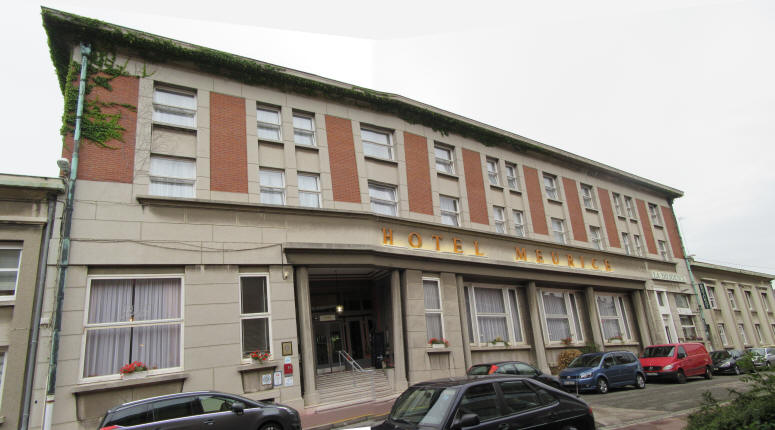
The lobby revealed a very folksy, homey feeling as I walked up to the desk and checked in. You can see through the end door (below right) they have a little cocktail bar.
I took the bags up the elevator and when I got off I took this look down the stairs into the entry. On our floor they have a very nice seating area but I never saw anyone sitting in it.
We were impressed; the rugs in the hallway were nice and quite clean. I took these photos looking in both directions down the hall from our room.
Here is what our room looked like - very nice.
Above and below are PhotoStitchs of Canon shots. I never do selfies but try hard to hide from mirrors when taking these shots. It looks like I was unsuccessful in this room.
These are the GoPro camera shots.
After getting organized, I went down to see what the breakfast area (below left) and the meeting room area (below right) looked like. Quite nice.
I felt it was time for a beer, so I went into their very cozy little bar at the end of the lobby.
I sat down and ordered a Belgian Leffe beer and then this friendly black dog sauntered up to me.
He looked at me as if he wanted something. The guy at the desk told me he wants to fetch his toy. So I threw it out across the lobby and he dashed like crazy to get it and immediately dashed back to me and dropped it at my feet then stared at me pleading me to do it again. So I did. After about twenty times, the guy told me "He won't stop" so I finally got tired and quit. I've never seen a dog fetch something and drop it at my feet like this dog did.
Marcia joined me for a glass of wine and then we headed out to see what we could
find. We wound up walking down to the Places d'Armes, a very large plaza
with stone benches and fountains spurting up. The two star Hotel Bel Azur
[23 Place d'Armes,
![]() +33-32-134-4810] anchors one end of the plaza (below left). This city has
painted elephants.
+33-32-134-4810] anchors one end of the plaza (below left). This city has
painted elephants.
Below left is a stock view of the plaza from the Bel Azur hotel and on the right are the fountains when lit up.
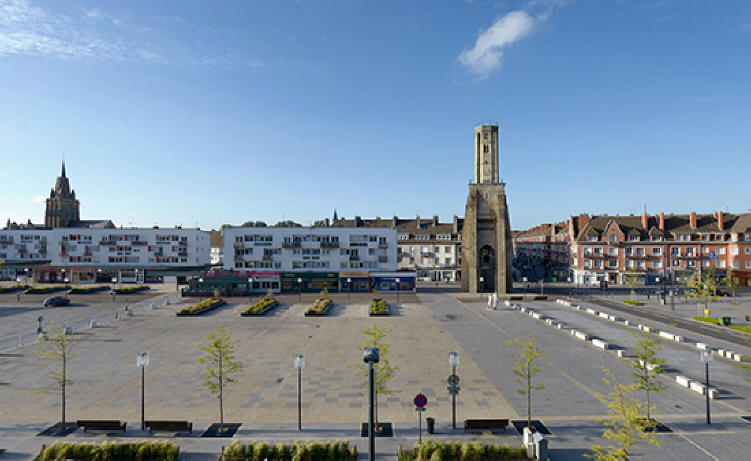
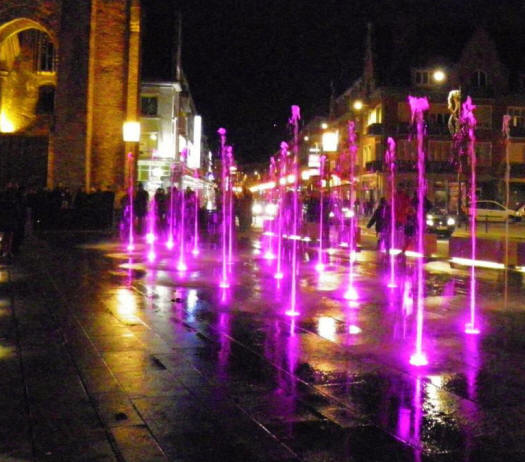
Below are two stock photos looking at the plaza straight on. You can see the Port cranes on left (below left).
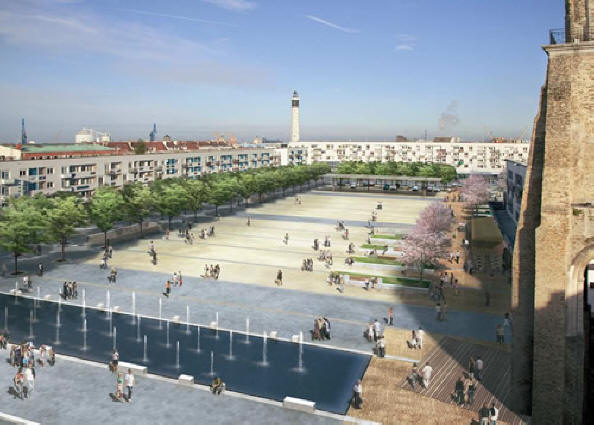
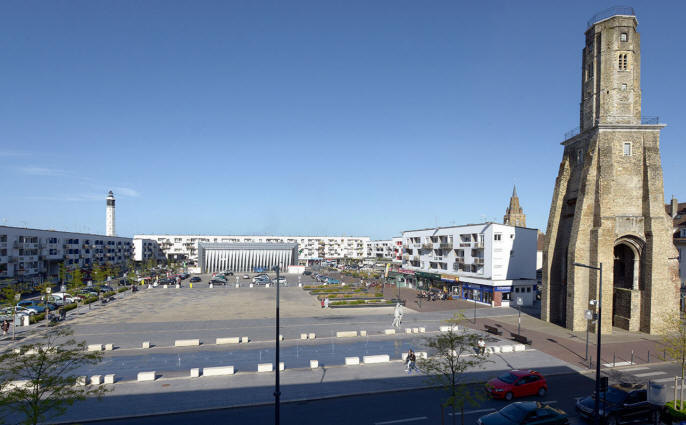
They had a plaque in the ground noting the renovation of the Place in 2013 and it opening in November listing all the dignitaries of the region.

The first attraction we came across was the Tour du Guet (above left and below).
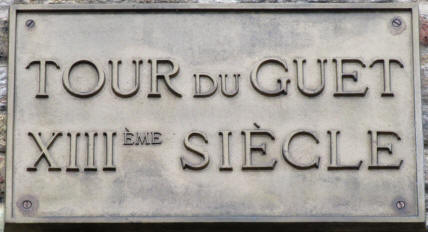
The Tour du Guet, or Watch Tower, was built in the 13th Century and was used as a lighthouse until 1848 when a new lighthouse was built nearer the port. It is one of the few surviving pre-war buildings. Dating from 1229, when Philip I, Count of Boulogne, built the fortifications of Calais, and the oldest remaining traces date to 1302. It has a height of 115 ft (35 m). In 1580, an earthquake split the tower in two and it almost completely collapsed . It was repaired in 1606 and then served as a hall to accommodate the local merchants. It was damaged again in 1658 when a young stable boy set fire to it, while it was temporarily being used as royal stables during a visit of King Louis XIV. It was not repaired for some 30 years, but in 1770, a bell identical to the original bell of 1348 was cast. Due to its height, from the late 17th Century, it became an important watch post for the city until 1905; the last keeper of the tower was forced to leave in 1926. Abraham Chappe installed a telegraph office in the tower in 1816 which operated for 32 years. It was from here that the death of Napoleon I was announced to the French public in 1821. It also had the dual function as lighthouse with a rotating beacon fuelled by oil from 1818. During WWI, it served as a military observation post and narrowly missed destruction during WWII. This tower was classified as a historic monument in 1931.
As we walked further down the plaza heading to the sea and the newer lighthouse, we could see there was a band playing in this large open arena.
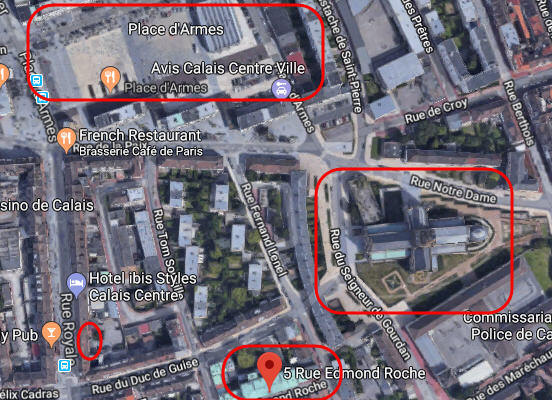
Then at the entry to the plaza is a statue (below left) of Gen Charles De Gaulle and his wife Yvonne Vendroux which Marcia reluctantly posed in front of. They were married here in Calais (where she is from) in 1921 at the church of Notre-Dame (below right, stock photo), which was built during the English occupancy of Calais. In the map above right you can see it is not far from the plaza or our hotel.
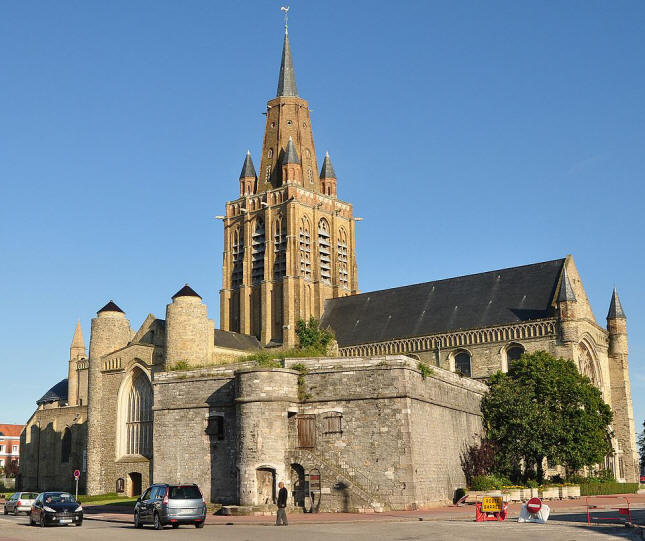
It is located south east of the this plaza and is arguably the only church built in the English perpendicular style in all of France. Since we did not get to the church, here are some more stock photos of it from different angles. You can see the Tour du Guet (below left) just off to the right. We could have seen it if we walked a couple of blocks.
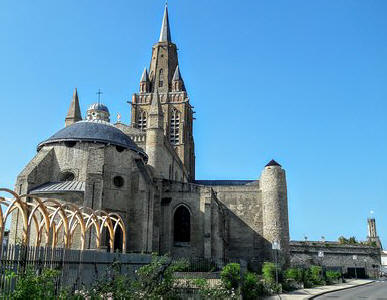
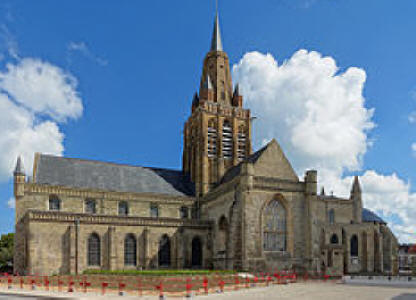
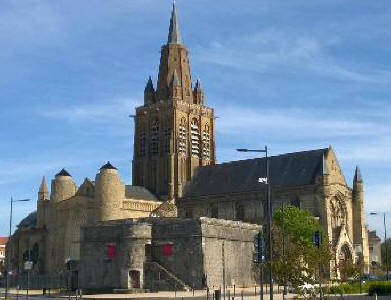
 It was now 8:15 PM and we came across this delightful little English pub called
The London Bridge [12 Place d'Armes,
It was now 8:15 PM and we came across this delightful little English pub called
The London Bridge [12 Place d'Armes,
![]() +3-32-185-8579] (below left). We went in and, standing at the "no seats"
bar, we ordered a beer and a glass of wine for �9.20.
+3-32-185-8579] (below left). We went in and, standing at the "no seats"
bar, we ordered a beer and a glass of wine for �9.20.
Here are some stock photos of the place; outside and in.
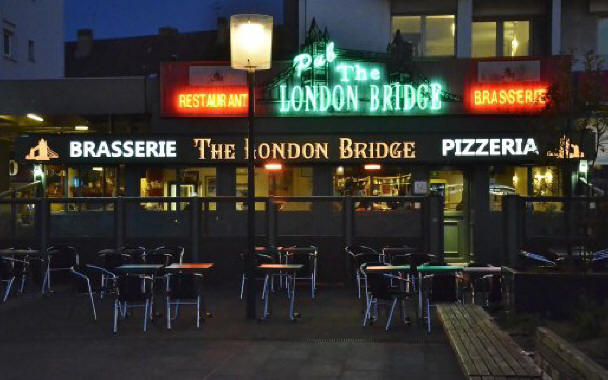
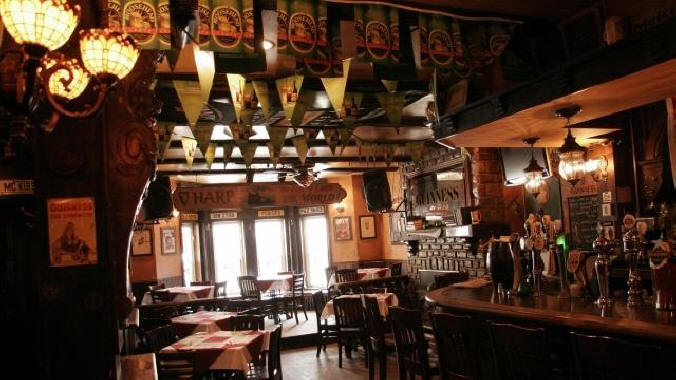
We had left our hotel (H) and walked to the Place d'Armes. We left the pub in the plaza at 9:00 PM and headed down the main street, Rue Royale, back in the direction of the hotel (map below).
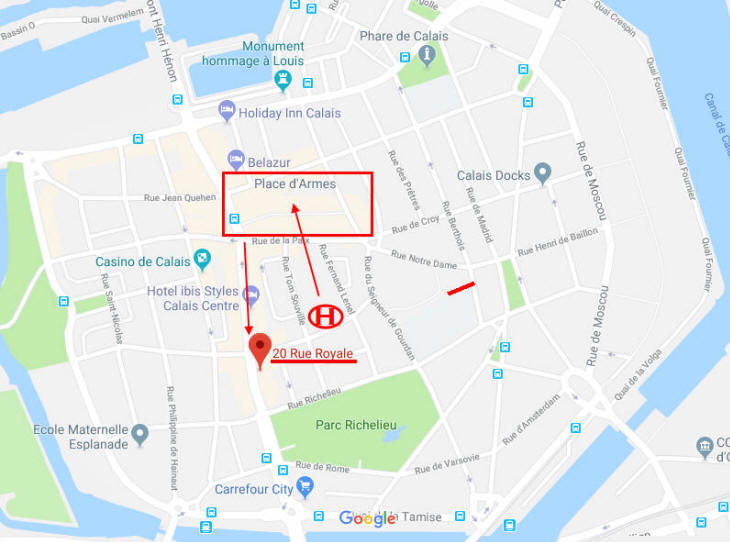
You can see in the map above that the large Parc Richelieu is only a block from the hotel. This may be a good place to run tomorrow.
We soon found the restaurant that our hotel recommended: the
Histoire Ancienne [20 Rue
Royale,
![]() +32-32-134-1120]. It looked very cute from the outside and in the left
window they had this large menu board explaining their offerings. This has
to be as cute classical French as you can get.
+32-32-134-1120]. It looked very cute from the outside and in the left
window they had this large menu board explaining their offerings. This has
to be as cute classical French as you can get.

You walk in that door and turn around and this is the PhotoStitch view of the bar area.
The lady seated us at a nice table (Marcia in center). It was just delightful; I hope the food is as good. Below right is their listing in a book of retaurants.
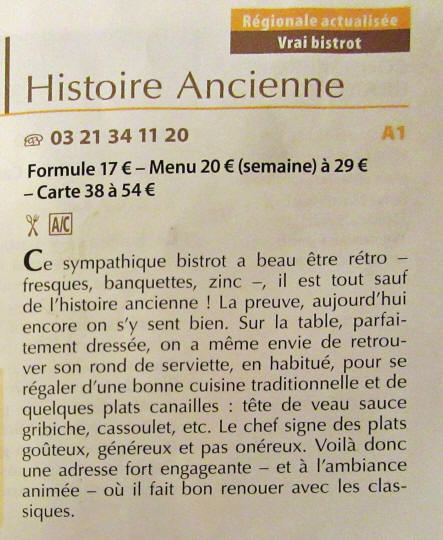
We looked over their menu and they had fixed menus; "Bib Gourmand" at �31 and "Menu Histoire Ancienne" at �19.50 but we usually shy away from them. After years of French restaurants we could figure out most of the dishes with a little help.
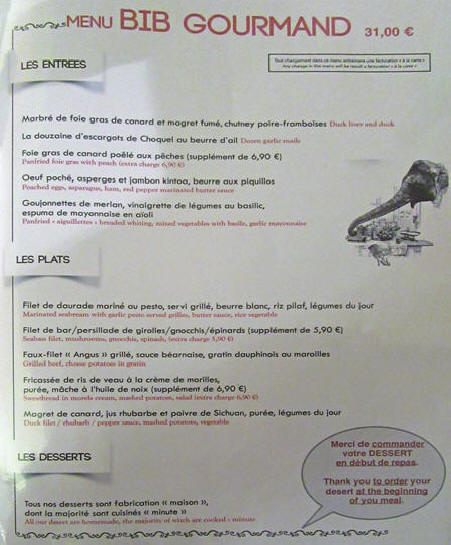
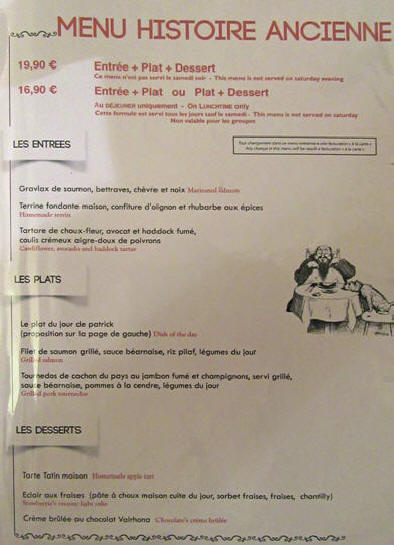
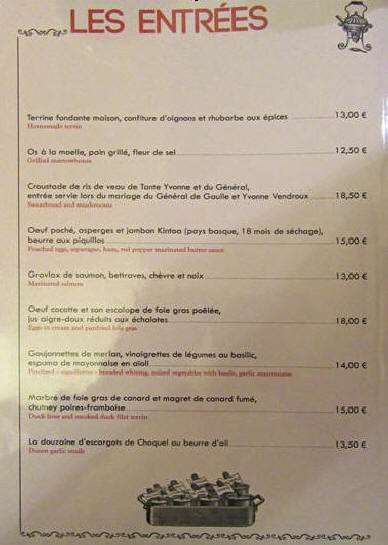
We ordered a bottle of mineral water and a bottle of house red wine which was a 2011 Ch�teau Frontenac Bordeaux Sup�rieur, a name we had heard of before. It was the cheapest wine on their list (�21) and it was excellent. She brought us some toasted bread with a huge pat of fresh butter on this stone plate with salt and a creamy cheese spread.
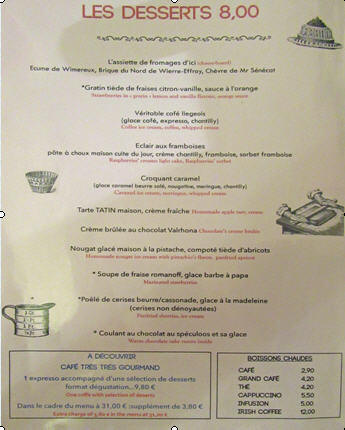
Then in Marcia's pre fixe she ordered a Homemade terrine with onions and rhubard (Terrine fondante maison, confiture d�oignon et rhubarb aux �pices) (below left). When I read the menu, it turns out that on their fixed menu (Bib Gourmand) they had two things I just love. The first is escargot (snails); usually (�13.50). So, below right is their twelve garlic butter snails (La douzaine d'escargots de Choquel au beurre d'ail). They were fantastic.
It is unusual that I did not select the magret de canard (duck breast) but the second thing I love is seeing the words "ris de veau" meaning veal sweetbreads (Fricasse� de ris de veau � la crēme de morilles pur�e, m�che � l'huile de noix) on the �31 Bib Gourmand menu. She brought it to me in this three stacked bowls arrangement (below left). I unstacked them; the upper had the salad, the middle had the mashed potatoes and the bottom one had the sweetbreads in morel mushroom puree sauce.
Here it is plated (below left). What a hearty meal. My heavens this was out of this world delicious. I want to move here. I ate the whole thing and didn't mind paying the extra �7 for it. Marcia ordered from the "Menu Histoire Ancienne" (�19.50) and had Grilled salmon with rice and string beans (Filet de saumon grill�, sauce b�arnaise, riz pilaf, l�gumes du jour). She loved it.
Since your choice of their desserts are included in the fixed menus (usually �8), Marcia had a delicious Chocolate�s cr�me br�l�e (Cr�me br�l�e au chocolat Valrhona) (below left) and I enjoyed a fantastic house made apple tart with cream (Tarte TATIN maison avec cr�me fra�che) (below right).
This entire fabulous, memorable meal cost us �84.20 ($104) and the tip is included (service compris) but that didn't stop me from adding more.

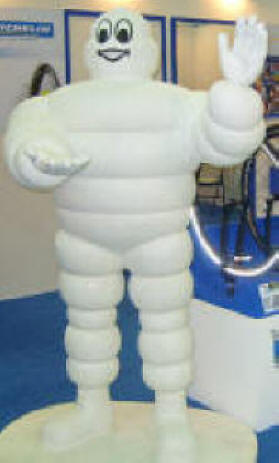
Here's something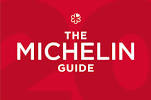 of value to travelers. I have since learned that beginning in 1955, the
Michelin guide has highlighted restaurants offering "exceptionally good food at
moderate prices", a feature now called "Bib Gourmand". They must offer
menu items priced below a maximum determined by local economic standards.
Bib (Bibendum) is the company's nickname for the Michelin Man (above right), its
corporate logo for over a century.
of value to travelers. I have since learned that beginning in 1955, the
Michelin guide has highlighted restaurants offering "exceptionally good food at
moderate prices", a feature now called "Bib Gourmand". They must offer
menu items priced below a maximum determined by local economic standards.
Bib (Bibendum) is the company's nickname for the Michelin Man (above right), its
corporate logo for over a century.
Marcia posed with Claire (the owner-chef's wife) who was fantastic and treated us especially nicely. I also later learned that the restaurant is owned by the chef, Patrick Comte (stock photo, below right). My hat's off to you sir for giving us one of the most lovely meals and evening we have had in a long time. Again, this is what travel is all about.
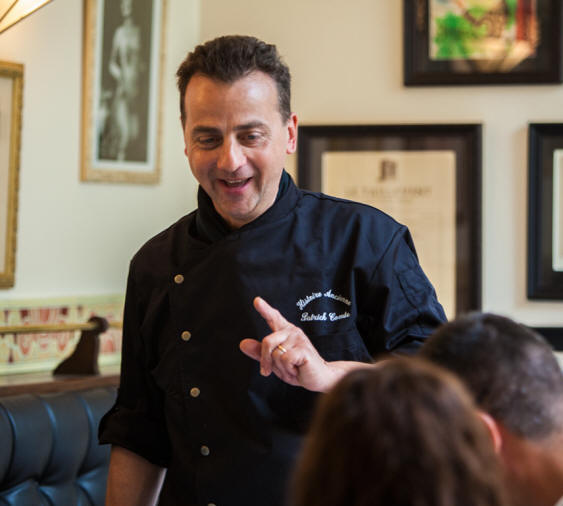
We left the restaurant at 11:30 PM and casually made the short walk back to our hotel and got to bed at 1:00 AM. Tomorrow we are off to England. What a beautiful surprise Calais was for us!
KJH
Go
To
� NEXT DIARIO #4
![]()
Kenneth J. Hoffer, MD
Calais, France
Sent 3-20-2018
If you enjoyed these travels or wish to add comments on the places we visited
Please Leave Me a Message by clicking the spinning @ sign below.

